REBNY ON 2025:

James Whelan, President, Real Estate Board of New York





























































James Whelan, President, Real Estate Board of New York



























































In shifting markets, we’re taking the long view, so you can seize the moment — now and for years to come.













EDITORIAL
Editor
Debra Hazel
Director of Communications and Marketing
Penelope Herrera
Director of Newsletter Division
Cheri Phillips
PRESIDENT/CEO
Jeff Mann
ART
Art Director
Serena Bhullar
Associate Graphic
Designer
Caroline Thomas
Cover Photography
Jill Lotenberg/REBNY
CONTRIBUTORS
Phillip J. Consalvo
Frank DeLucia
Merilee Kern
Kris Kiser
Greg Papeika
Stuart Saft
James F. Schnars
Dan Sharplin
Carol A. Sigmond
Stephen Smith
Scott Spector
Steve Tishco
Brian Turner
BUSINESS
Technology Consultant
Eric Loh
Distribution Mitchell’s Delivery Service
DIGITAL MEDIA
Designers
Serena Bhullar
Caroline Thomas
Editors
Natalia Finnis-Smart
Debra Hazel
Penelope Herrera
Cheri Phillips
Web Developer
CS Designworks
West Coast Office: 578 Washington Blvd., Suite 827 Marina Del Rey, CA 90292 866-306-MANN (6266) mannpublications.com



East Coast Office: 450 7th Ave, Suite 2306 New York, NY 10123 212-840-MANN (6266)






For 50 years, R&E's attorneys have been instrumental in driving the firm's success, helping R&E achieve remarkable milestones and putting the firm at the forefront of the real estate industry.
Meridian’s national dominance in multifamily financing gives us a unique vantage point from which to approach markets on our clients’ behalf. By leveraging our 30+ year relationships and depth of experience, we are able to see what others can’t and produce exceptional outcomes — especially in turbulent markets. Remain informed and be agile with Meridian.






For more than 125 years, in good times, in bad times, in all times, the New York City real estate industry has had one constant to rely on: the Real Estate Board of New York. Whether it is supplying critical data to help us benchmark transactions, hosting networking events including last month’s amazing gala or lobbying our public officials to strengthen real estate, REBNY never stops working to make us and our business better.
REBNY is, simply, the voice of our industry, and we’re thrilled to feature that voice on our cover this month.
Speaking of galas, as you’ll see in these pages, the industry was back to full celebrations of the holidays and the new year.
And at the National Realty Club (NRC), we’re kicking off a new year of Fireside Chats with my dear friend, our very first Mann Report cover subject and industry icon Bob Knakal who will be discussing “Reinventing Real Estate” — and no one is better qualified to do so. At his new company, BK Real Estate Advisors, Bob is blending new technologies with old-fashioned industry knowledge and dealmaking to change how real estate is bought and sold. Join us on March 3 from 5:30 p.m. to 7:30 p.m. at the spectacular, newly renovated Versa on the seventh floor of the Renaissance Hotel (218 West 35th St.)
The event is free for NRC members, $200 for nonmembers. For more information about the event or the NRC, email Penny Herrera at penny@ nationalrealtyclub.com.
See you next month!

“Cooperation is the thorough conviction that nobody can get there unless everybody gets there.” — Virginia Burden






















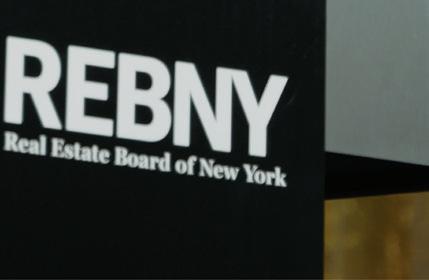





Ongoing
Strictly




Sayings become cliches because there’s an element of truth to them, and this issue epitomizes the statement that “Great minds think alike.”
We’re blessed to have extraordinary contributors share their experience and expertise with us, and this month has a couple discussing the growing importance of “accessory dwelling units,” small, fully equipped homes built near a primary residence. These mini-homes are providing an income stream, or much-needed housing for older generations or young adults.
Merilee Kern’s interview with Maxable’s Paul Dashevsky and Jon Grishpul offers a guide to why and how to build in this format, while our Commercial Corner interviewee, Robert Wasmund of Ascent Developer Solutions, discusses financing. Given today’s housing shortage around the country, it’s a trend to be watched.
Elsewhere, our friends at Ditchik & Ditchik remind us that the deadline for most property owners to protest their New York Tax Commission assessments is March 1, among other deadlines. And if you’re craving the sun by now (who isn’t in February?), check out our feature on Naples, Florida.
Thanks to all the great minds who continue to enlighten us.




Photos by Brooke Alexander
Law firm Fried Frank’s Real Estate Department hosted its annual Real Estate Holiday Party at Cipriani 42nd Street. The party, which aims to show the firm’s appreciation to its valued lawyers, clients and friends in the real estate industry, welcomed over 900 guests.







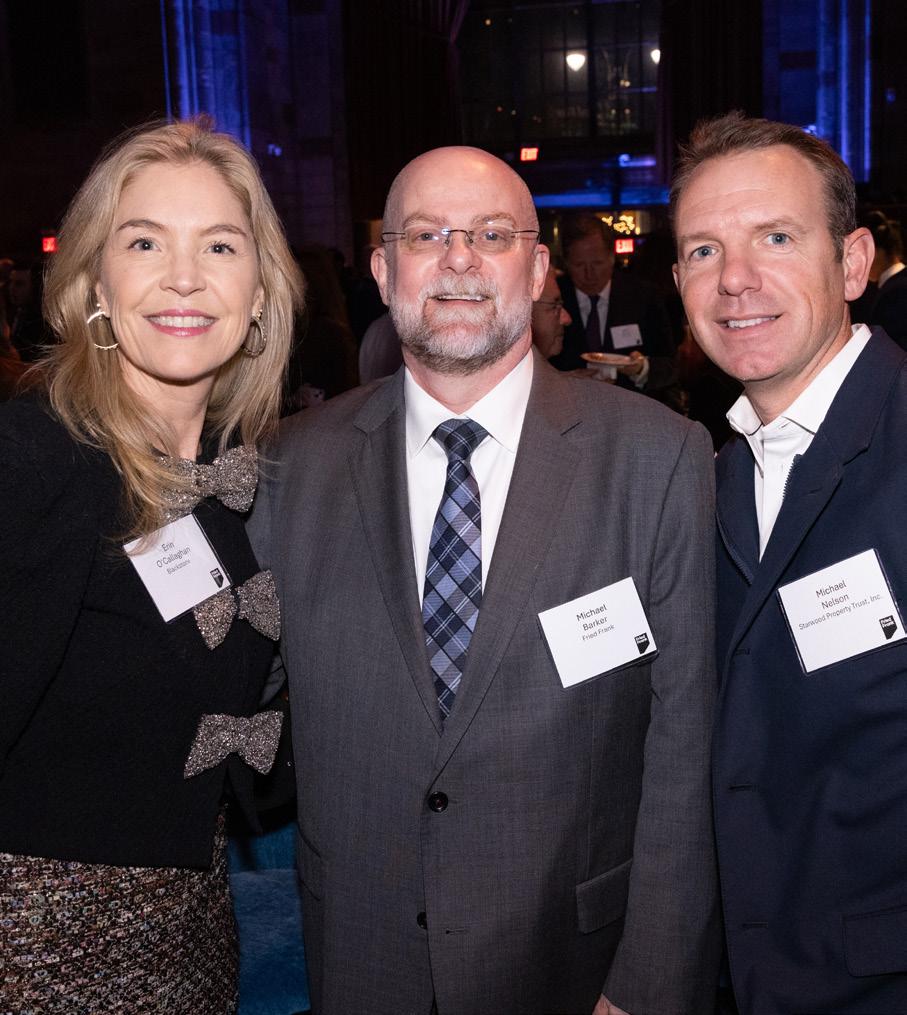



CREW New York held its annual Holiday Party at The Lotos Club, featuring a celebration of CREW New York’s 2024 Member Recognition awards and the announcement of this year’s Past Presidents’ Scholarship recipients.
CREW New York’s Member Recognition awards honored esteemed professionals who have made a significant impact on the association and the commercial real estate industry as a whole. This year’s categories recognized three influential members for their commitment, contributions and service and one company for their dedicated support and empowerment of CREW New York.
Star of the Year was Robin Landow, principal, Landow and Landow Architects. She is a CREW New York board member and chair of the Career Advancement committee, overseeing the Mentorship Program, CREW Careers and the philanthropic activities including the Holiday Party’s toy drive in collaboration with Toys for Tots and hygiene kit drives for Women in Need.
Also Star of the Year was Kenne Shepherd, founding principal, Kenne Shepherd Interior Design Architecture. Shepherd has been a CREW New York member for 24 years and currently serves as a board member and chair of the Programs committee. She has been a driving force behind CREW New York’s signature events including the monthly luncheons, summer Leading Ladies of Real Estate series and tours of landmark buildings across New York City.
Named Rising Star was Andrea Palacios, assistant vice president, Santander Bank. She joined CREW New York as a past presidents’ scholarship recipient and now serves on both the Career Advancement and Young Professionals committees.
Sponsor of the Year was Akerman, a longtime supporter and Silver Sponsor of CREW New York. It hosts CREW New York’s signature Leading Ladies of Real Estate series each summer that highlight trailblazing women from around the commercial real estate industry.
The night also included the announcement of the 2024 Past Presidents’ Scholarship recipients: Joane Kim, Columbia University GSAPP; Christine Kim, Columbia Business School; Jessie Pan, Columbia University GSAPP, Miki Ji, NYU Schack Institute of Real Estate and Katy Lepeturin, Columbia Business School








Photos courtesy of Louis Gilbert Photography
Project REAP (Real Estate Associate Program) celebrated its DC Silver Jubilee at Skyline 609, honoring its 25th anniversary. Launched in Washington, D.C., REAP has graduated 275 Fellows from the greater Washington area and over 2,000 alumni nationwide.
The event also introduced REAP newly appointed Executive Director Taneshia Nash Laird. Nash Laird, most recently the inaugural president and CEO of the Greater Roxbury Arts & Cultural Center, is the former president and CEO of Newark Symphony Hall, the cofounder of the entertainment venue MIST Harlem and was a New Jersey municipal and state economic development official.
“She’s an entrepreneur, she’s a steward, she’s a mentor, she’s a mom of two teenaged girls, and she’s an amazing leader,” said REAP Chair of the Board Michael Kercheval.
The event also honored Buwa Binitie, founder and CEO of the Dumas Collective and a REAP alumnus in 2005, as DC REAPer of the Year, voted on by an overwhelming majority of area alumni.


Nash Laird praised Binitie’s commitment to “creating and preserving affordable and workforce housing,” noting that he and his team at Dumas Collective have closed over $2.3 billion in financing, resulting in over 8,000 workforce and affordable units through unconventional real estate transactions that utilize low income housing tax credits, New Market tax credits, tax exempt bonds and other forms of alternate financing.
“I can’t thank REAP enough for giving me an opportunity to live my dream. This recognition is more important than any … I’ve ever received because this is where I started,” Binitie said. “You can’t be what you don’t see.”
REAP Founder Mike Bush, president of The Minority Resource and an adjunct professor in urban development at Georgetown University, also was honored at the event.





Photos by Stefan Klapko
The Met Council welcomed more than 500 attendees at this year’s Annual Benefit who gathered to celebrate the vital assistance Met Council provides to over 325,000 New Yorkers in need each year. In 2024, Met Council is especially proud to have distributed nearly two million pounds of food each month, provided emergency support to the more than 1,000 families facing domestic violence and secured over 20 million dollars in SNAP funding for its clients.
One of the night’s highlights was a stunning sculpture: an apple crafted from 3,496 tuna cans, commissioned from DeSimone Consulting Engineers. Each can symbolizes acts of kindness that nourish and uplift the lives of our neighbors in need. Following the event, the cans will be distributed to nearly 3,000 Holocaust survivors as part of Met Council’s weekly food packages. The evening was made even more memorable by the incredible entertainment of Josh Beckerman, the Foodie Magician, who captivated attendees with his unique blend of humor, magic and culinary charm.
During its program, Met Council honored Michelle and Adi Chugh with the Community Leadership Award, inspired by Adi’s moving message of three life maxims to live by. Additionally, Ben Gershenfeld was recognized with the Young Leadership Award, representing the next generation of changemakers.
The benefit also drew over 30 elected and appointed officials, including New York Attorney General Letitia James and New York State Comptroller Tom DiNapoli, along with philanthropists and community leaders — all united in their commitment to combating poverty.
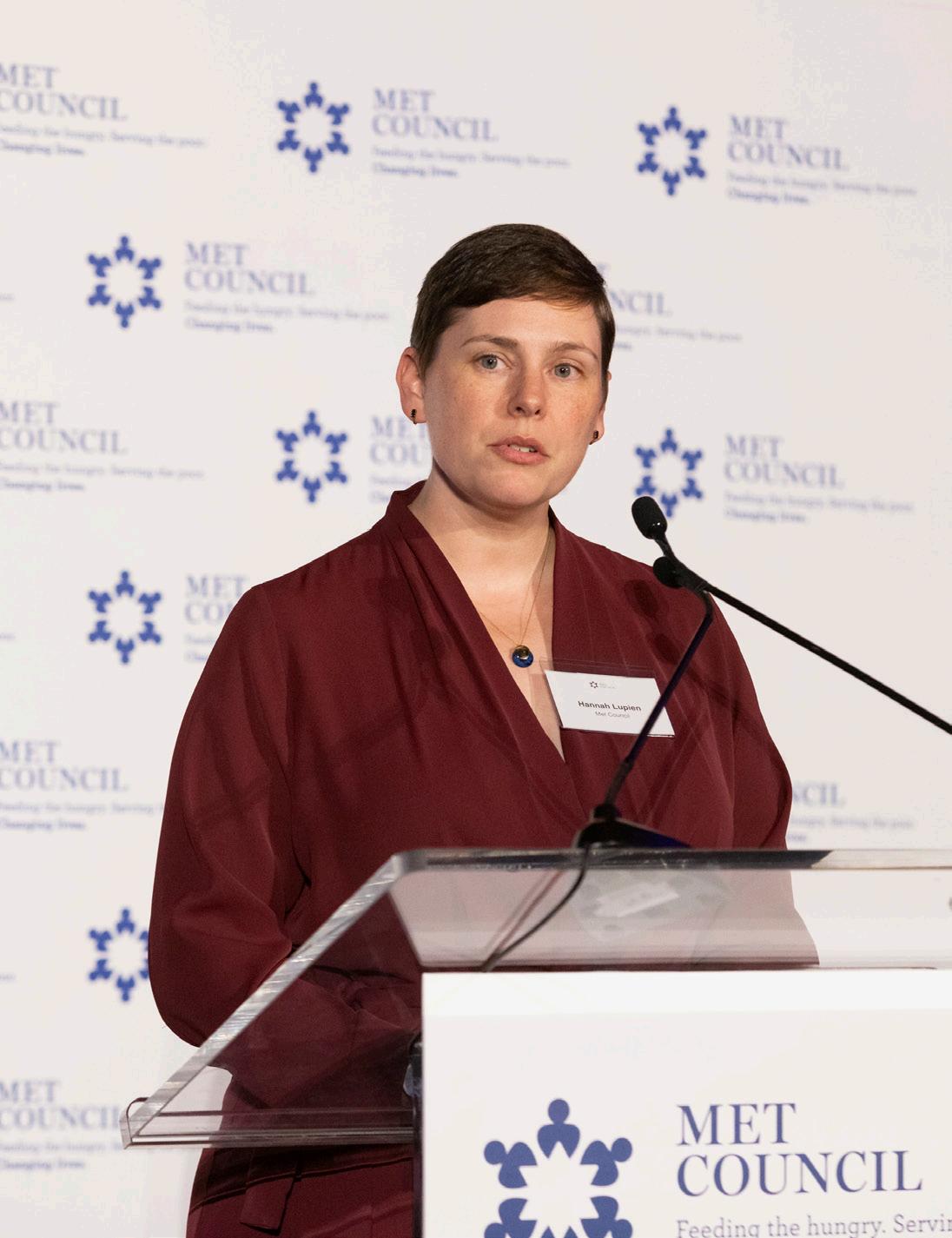










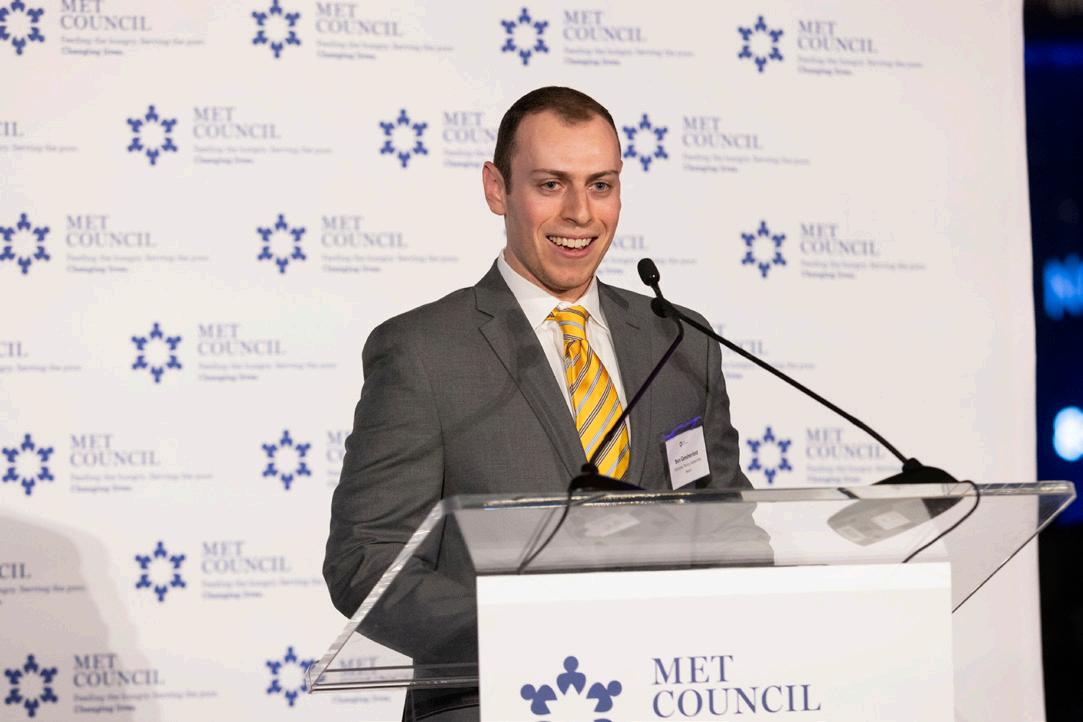






The New York Apartment Association (NYAA) held its first annual cocktail party at the Tribeca Rooftop. NYAA was formed in 2024 by merging the Community Housing Improvement Program (CHIP) and the Rent Stabilization Association (RSA). NYAA launched in September 2024 as a means for the industry to have a unified, singular voice to advocate for better housing policy that will incentivize growth and make abundant housing possible.
More than 600 industry experts, members and leaders came together to network and build community within the industry. In an often-fraught political landscape for real estate, this event provides an opportunity for members and industry professionals to connect and converse..





The 57th Annual NYU Conference on Capital Markets in Real Estate, hosted by the NYU School of Professional Studies Schack Institute of Real Estate, brought together commercial real estate industry icons and up-and-coming leaders to explore how the improving macroeconomic sentiment and shifts in the global economy will shape opportunities and risks in real estate capital markets moving into 2025.
“Capital markets are the lifeblood of the global real estate market, and for 57 years, the NYU SPS Annual Conference on Capital Markets in Real Estate has been the foremost and most enduring thought leadership forum for the global real estate capital markets,” said conference co-host Marc Norman, Larry & Klara Silverstein chair in real estate development and investment, and associate dean of the NYU SPS Schack Institute of Real Estate. “This year’s speakers and panelists shared their insights and perspectives on the recent infrastructure boom, financing for sustainable workforce housing, the capital markets for alternative real estate assets, global equity investments and the next generation of leaders shaping the industry, among other topics.”
This year’s NYU Conference on Capital Markets in Real Estate also celebrated the 25th Anniversary of the event’s most popular session, the annual Golden Apple Panel, which highlightspioneering leaders who continue to shape the sector. These leaders have faced challenges and seized opportunities with resilience and foresight.
The 2024 edition of this panel, moderated by Robert S. Blumenthal ’80, featured Jeff Blau of Related Companies, Marty Burger of Infinite Global Real Estate Partners, MaryAnne Gilmartin of MAG Partners, Scott Rechler of RXR and William C. Rudin of Rudin.
The discussion explored key trends, shared insights on today’s most pressing issues and discussed how long-standing principles are being challenged and redefined in response to new market demands with this group of industry visionaries







We are constantly upgrading our approach and methods to save our clients time and money by delivering the most progressive services and tools in the industry.
Why? To always increase the value of our buildings and enhance the lifestyles for our residents.
Large to small, we tailor all our services to meet the unique needs of each of our clients. A total commitment to quality service is what has made Century one of the most trusted management companies in New York for over 40 years.
Connect with our expert team today to find out how we can help. OUR EXPERTISE AT A GLANCE Residential Property Management
Financial Management
Risk Management
Residential Sales & Rentals
Coop and Condo Conversions
Construction Coordination
Project Management



Taking its first office in New York City, IGI Global Scientific Publishing has signed for 4,000 square feet at 250 Broadway, a 648,000-squarefoot office property in Lower Manhattan, announced AmTrust RE. AmTrust’s Anne Holker and the CBRE team of Brad Gerla, Michael Rizzo and Alex Benisatto represented the landlord in the transaction, while the tenant was represented by Aaron Winston of Newmark.
IGI Global Scientific Publishing is an international academic publisher of scientific research books, journals and encyclopedias with a focus on business and management; science, technical and medical and education and social sciences.
“With interest rates falling and other positive economic indicators, we’ve seen strong leasing activity over the past few months across our New York City office portfolio,” said Jonathan Bennett, AmTrust’s president. “Companies are coalescing around the idea that a postCOVID-19 world requires a highly designed, well-located office setting that is easily accessible to workers and positions them for professional success. As a well-regarded academic publisher, IGI Global Scientific Publishing is an exciting new addition to our tenant roster. Their move to 250 Broadway is additional proof of the success we’ve had at elevating this office property for premier local and national commercial tenants.”
The building is located directly across the street from City Hall Park

and is home to several law firms, New York City Council, New York City Housing Authority, New York State Assembly and New York State Senate. Originally constructed in 1962, the property has received significant capital improvements in recent years, including major upgrades to the lobby, elevators and other common areas.
Nordstrom Inc. has signed a definitive agreement under which Erik, Pete and Jamie Nordstrom, other members of the Nordstrom family and El Puerto de Liverpool, S.A.B. de C.V. will acquire all of the outstanding common shares of Nordstrom not already beneficially owned by the Nordstrom family and Liverpool. The all-cash transaction is valued at approximately $6.25 billion on an enterprise basis. Following the close of the transaction, the Nordstrom family will have a majority ownership stake in the company.
Under the terms of the agreement, Nordstrom common shareholders will receive $24.25 in cash for each share of Nordstrom common stock they hold. In addition, the board intends to authorize a special dividend of up to $0.25 per share immediately prior to and contingent on the close of the transaction. Nordstrom will become a private company.
“For over a century, Nordstrom has operated with a foundational principle of helping customers feel good and look their best,” said Erik Nordstrom, CEO of Nordstrom. “We look forward to working with our teams to ensure Nordstrom thrives long into the future.”
“Nordstrom is one of the worldwide leaders in department store retailing, and we’re thrilled to be investing in a company that has meaningfully shaped the industry for nearly 125 years,” said Graciano F. Guichard G., executive chairman of Liverpool.
The transaction is expected to close in the first half of 2025. It will be financed through a combination of rollover equity by the Nordstrom family and Liverpool, cash commitments by Liverpool, up to $450 million in borrowings under a new $1.2 billion ABL bank financing, and company cash on hand. Following the closing of the transaction, Nordstrom will be owned 50.1% by the Nordstrom family and 49.9% by Liverpool.
Morgan Stanley & Co. LLC and Centerview Partners LLC are acting as
$6.25B
financial advisors to the special committee, and Sidley Austin LLP and Perkins Coie LLP are acting as legal counsel to the special committee. Moelis & Company LLC is acting as financial advisor and Wilmer Cutler Pickering Hale and Dorr LLP, Lane Powell PC and Davis Wright Tremaine LLP are acting as legal counsel to the Nordstrom family. J.P. Morgan Securities LLC is acting as financial advisor and Simpson Thacher & Bartlett LLP and Galicia Abogados S.C. are acting as legal counsel to Liverpool.



JCPenney and SPARC Group have combined to form a new organization, Catalyst Brands, creating an unmatched portfolio of six retail banners.
Catalyst Brands brings together SPARC Group’s brands Aéropostale, Brooks Brothers, Eddie Bauer, Lucky Brand and Nautica with JCPenney and its exclusive private brands, including Stafford, Arizona and Liz Claiborne. Catalyst Brands, which has served over 60 million customers over the past three years, boasts more than $9 billion of revenue, 1,800 store locations and 60,000 employees.
The combined Catalyst Brands organization is a joint venture formed in an all-equity transaction between JCPenney and SPARC Group, with shareholders Simon Property Group, Brookfield Corporation, Authentic Brands Group and Shein. In addition, Catalyst Brands has sold the U.S. operations of Reebok and is exploring strategic options for the operations of Forever 21.
Marc Rosen, formerly the chief executive officer of JCPenney, has become CEO of Catalyst Brands. Michelle Wlazlo, formerly the chief merchandising and supply chain officer of JCPenney, has been promoted to brand CEO of JCPenney. Natalie Levy continues her role as brand CEO of Aéropostale, Lucky Brand and Nautica and Ken Ohashi will continue leading Brooks Brothers and has assumed responsibility of Eddie Bauer in his new role as brand CEO of both. Kevin Harper, formerly an executive with Walmart, will join Catalyst
Brands as chief operating officer. Marisa Thalberg, formerly the consulting chief marketing and brand officer of JCPenney, has become the chief customer and marketing officer of Catalyst Brands.
Catalyst Brands is headquartered in Plano, Texas with offices in New York, Los Angeles and Seattle.

In the largest CMBS loan ever issued for a single office asset, Tishman Speyer successfully completed a $3.5 billion refinancing of the Rockefeller Center campus.
Bank of America and Wells Fargo served as co-lead managers on the five-year Single Asset Single Borrower (SASB) loan with a fixed interest rate of 6.2265%. The proceeds will be used to pay off Rockefeller Center’s previous 20-year, $1.7 billion CMBS loan and additional mezzanine financing set to mature in May 2025, and fund reserves for contractual leasing costs.
The 7.3 million-square-foot campus encompasses workspaces, multilevel retail, popular attractions, private event spaces and dining options, as well as dynamic open spaces including the new 24,000-square-foot park atop Radio City Music Hall. Rockefeller Center is co-owned by Henry Crown & Co., the Crown family’s Chicago-based investment fund, and Tishman Speyer.
“We are proud of our stewardship of Rockefeller Center,” said Tishman Speyer CEO Rob Speyer. “The lending market’s overwhelming response speaks volumes about the success of our redevelopment and their confidence in top performing assets.”
The massive refinancing has been secured as Tishman Speyer’s comprehensive redevelopment of the renowned 13-building campus nears completion.
Tishman Speyer’s capital improvement program, inspired by the Center’s original plans and history, has restored the intent of the Channel Gardens and Rink areas as grand and welcoming entrance points for the public. The company has opened the lower-level
passageways surrounding the Rink, creating a light-filled space that prioritizes efficient pedestrian flow and easing access to skating and public art in the center of campus.
The Rink Level is now home to marquee restaurants from celebrated independent chefs, including Le Rock, 5 Acres, Jupiter, Lodi, Naro, Pebble Bar, Smith & Mills and others. Tishman Speyer has similarly pursued a retail transformation at the Center, reinvigorating its offerings with distinctive shops helmed by local entrepreneurs alongside global brands, including Lego, Banana Republic, Anthropologie, Michael Kors, Catbird, FAO Schwarz and Nintendo.
Rockefeller Center is currently 93% leased.

Christie’s International Real Estate Group announced the newest addition to its New Jersey division: The Highland Group, based in Westfield, N.J. This dynamic team marks another significant milestone in Christie’s continued expansion and market leadership across the state, the firm said.
With over 20 years of collective real estate experience and more than $100 million in sales, The Highland Group will represent the Christie’s brand in Westfield and throughout New Jersey. Launched in June 2023, its team of nine agents brings extensive expertise, deep local knowledge and valuable connections to their new role. The team members, previously with Keller Williams, include Amelia Sarrazin, Erin McMahon, Lindsay Kaup, Matt Jarecki, Megan Brown, Sandra Bliwise, Suzanne McMahon, Todd Mitchell and Katelynn Whitlock Leemhuis.
The Highland Group has teamed up with renowned local artist Ricardo Roig to co-launch a Christie’s brand boutique at Roig Studio, located at 245 East Broad St. in downtown Westfield. This unique partnership offers a collaborative space where real estate and art come together.
As part of their commitment to community engagement, Christie’s and Roig plan to host a series of exclusive monthly events in the shared gallery space. These events, open to both agents and Westfield residents, will include wine tastings, curated shopping experiences and art auctions benefiting local charities, among others, further solidifying Christie’s presence in the community.
“We are thrilled to welcome The Highland Group to the Christie’s family. Each of the nine agents brings a wealth of experience and a proven track record of success. We couldn’t think of a better team to represent

Christie’s in Westfield,” said Alex Ristovic, regional vice president at Christie’s International Real Estate Group New Jersey. “We look forward to seeing The Highland Group thrive and engage deeply with the local community.”
Coldwell Banker Warburg (CBW), the brokerage that has served New York luxury real estate for more than 100 years, is opening an outpost in Brooklyn. The new space will be located in the borough’s DUMBO neighborhood, and feature an industrial, open-concept design within a Two Trees Management co-working space.
“As we continue to grow, it’s clear that we need to expand our existing footprint in Brooklyn to help our agents meet the demands of its fastpaced market. Brooklyn isn’t just a borough; it’s a lifestyle, a vibe, and we’re here to bring our experience and network to this amazing community at exactly the right time,” said Kevelyn Guzman, regional vice president at Coldwell Banker Warburg. “We’re ready to continue to serve Brooklyn’s unique needs with the same expertise and personalized touch that define our work in Manhattan. With this office as our home base, we look forward to forging new relationships, serving our clients and expanding our role in building Brooklyn’s ongoing story.”
The Brooklyn office will serve as a satellite location next to CBW’s main operations in Manhattan, with an existing team supporting its growth and operations. It will also have a dedicated creative area for agents and brokers, allowing them to access resources for media production and personal branding outside of Manhattan.
“Agents and their clients are consistently choosing Coldwell Banker to leverage our strong support, service and resonance in the market, and the Brooklyn market is no exception,” said Kamini Lane, president and CEO of Coldwell Banker Realty. “We congratulate Coldwell Banker





RICHARD SIMON, ESQ. | PARTNER
CHAIR, BANKING AND FINANCIAL SERVICES

JEFFREY ROSENTHAL, ESQ. | PARTNER CHAIR, BANKRUPTCY AND CREDITORS RIGHTS
Since 1930, Mandelbaum Barrett PC has prioritized providing clients with proactive legal protection spanning over 30 practice areas:
Alternative
Banking
Just 21% of millennials believe their generation can afford homes, a sharp decline from the 52% who felt the same in 2024, according to new research from Real Estate Witch, an online publication owned by Clever Real Estate that connects readers with expert real estate advice. The result — many potential buyers will overlook some problems that would have disqualified a home not that long ago.
The median U.S. home price hovers around $420,000, but 68% of 2025 millennial homebuyers plan to purchase a home that costs less than $400,000. In comparison, just 57% of millennials planned to spend less than $400,000 in 2024.
Nearly all (96%) of millennial home buyers have concerns about purchasing a home, the survey said, with 44% worried about finding an affordable home — up from 35% in 2024.
Nearly all millennials (97%) face barriers to homeownership, with financial challenges topping the list: 52% cite high home prices, 48% point to high interest rates and 44% struggle to save for a down payment.
As a result, nearly half of millennials (41%) said that they would buy a home with asbestos or pests, such as mice, cockroaches and spiders, while 57% would make an offer on a fixer-upper.
Surprisingly, more millennials would prefer buying near a cemetery (34%) or railroad track (26%) than near their ex (25%), while 60% wouldn’t consider a home near their in-laws.
About 74% of millennials believe high interest rates make now a bad time


to buy a home, but 76% say they would be enticed to buy if rates fall in 2025.Over half (56%) would offer over asking price, though that figure has dropped from 79% in 2024.
Two in three (67%) of millennials regret not buying a home when prices were lower, and 32% expect to max out their budgets in 2025.
Nearly half of millennials (45%) think their generation faces the greatest challenges in affording homes, with 33% blaming boomers for being most responsible for the affordable housing crisis.
Pretium, a specialized investment firm with over $55 billion in assets under management, has secured $550 million in equity commitments from a diversified group of existing and new institutional investors to originate up to $5 billion in loans to homebuilders to create new and renovate existing stock across the United States.
The fund’s investment will consist of residential transition loans to facilitate the renovation of aged houses for homeownership with conventional mortgages; vertical construction loans on single family for-sale communities and build-to-rent communities and horizontal infrastructure loans to land developers/lot bankers.
“The success of this fund reflects the strength of our brand as a leading investor in residential real estate. It underscores the significant opportunity we see to help increase housing supply across the U.S. by filling the void left by regional banks in real estate lending,” said Jonathan Pruzan, co-president of Pretium. “Through this fund, Pretium will provide capital to homebuilders so that they can add critically needed inventory to the housing market.”
The fund will use the unique data and analytics capabilities of Pretium’s five residential real estate operating companies to make informed and timely credit decisions on residential housing projects across highgrowth markets in the United States. Additionally, the fund will utilize Pretium’s operating companies, including Anchor Loans, to directly originate and service loans for private homebuilders and developers, who previously relied on regional banks to fund their growth. On a leveraged basis, the fund has committed $650 million of capital to date to investment opportunities.

“By providing bespoke debt capital solutions, we’re supporting private homebuilders who are underserved by traditional financial institutions, and we are facilitating new housing supply,” said Josh Pristaw, Pretium’s head of real estate. “This fund will support the construction of approximately 12,000 new homes in key markets, meaningfully increasing housing availability in regions experiencing the most acute shortages.”
Kirkland & Ellis LLP served as legal counsel to Pretium on these investment vehicles.



Michael Baker International, a global provider of engineering, planning and consulting services, announced that the firm’s portfolio company, Akela Engineering and Consulting, is now fully merged into Michael Baker’s Sustainable and Resilient Solutions (SRS) business vertical. The SRS vertical encompasses the firm’s current mechanical, eectrical and plumbing (MEP), structural engineering, telecommunications, cybersecurity, fire protection and architectural services.
The merging of Akela, a national MEP+ firm with deep expertise in California, into Michael Baker offers clients holistic, smart and resilient building solutions across market sectors, the firm said. The action strengthens Michael Baker’s position as it focuses on growing private sector work in San Diego and the Southern California region as well as nationally, with the broader SRS team.
The firm plans to expand in sectors including Industrial, Defense OEMs, Aerospace, Data Centers, Semiconductors, Life Sciences, Energy Transition, Higher Education and Healthcare.
“With growth in the MEP space continuing to accelerate, concentrating our Akela and SRS teams into one cohesive entity strengthens our ability to expand our client base and position ourselves to deliver complex smart and resilient buildings, something only a full-service engineering firm can do well,” said Pankaj Duggal, president, Sustainable and Resilient Solutions at Michael Baker International. “The merger will continue to strengthen our competitive position in the growing MEP engineering and consulting market since acquiring and
uniting Michael Wall Engineering and DEC Engineers in 2022 to form Akela. This combined team also allows us to offer our clients access to even more expertise and services as we support their businesses and enables us to create and embrace new opportunities that enhance our pursuit of larger, more complex MEP projects.”

Home Value Lock, a market value insurance product for homebuyers, has been made available through Century 21’s Select Real Estate. The Sacramento, Calif.-area real estate group will provide clients the option to benefit from market value protection for their new home at no additional cost.
“We want to offer our homebuyers additional confidence in market values through this coverage,” said Select Group CEO Dan Jacuzzi. “Providing a product like this further demonstrates the meaningful benefit of working with Century 21 Select Real Estate professionals when you purchase a home.”
Home Value Lock Insurance, which was launched inn 2024 in Northern California, protects the first 10% of the purchase price of a home against a scenario where the market value has gone down when it gets resold. The product, which is fully licensed and regulated in the state of California, is the first of its kind to hit the marketplace.
“Homebuyers deserve some protection against unexpected housing market drops like what we saw during the 2008 Financial Crisis,” said Evan Weston, director of sales for OMT Insurance Services, which distributes Home Value Lock. “Outside of massive recessions, localized events like wildfires can have an impact on prices. Our coverage is designed to give the homebuyer some peace of mind, particularly in the first few years of homeownership, that the market value of their home is protected.”
Home Value Lock will be offered to Century 21 Select Real Estate’s homebuyers as a closing gift for those who have used a mortgage to finance their purchase. Availability will be across the greater Sacramento area but subject to the terms of coverage.


Accounting, tax and advisory firm PKF O’Connor Davies has opened a new office in Fort Lauderdale, Fla. The office, located at 200 East Las Olas Blvd. in the city’s downtown financial district, offers 5,000 square feet of office space and convenient, on-site amenities.
“As our work in southeast Florida continues to grow, the opening of our Fort Lauderdale office strengthens our market position and provides the necessary operating support to further scale our work in the region,” said Kevin J. Keane, executive chairman at PKF O’Connor Davies. “We look forward to joining Fort Lauderdale’s thriving business community and welcoming new and existing clients to our state-of-the-art space.”
With 23 offices in the U.S. and India, PKF O’Connor Davies’ new location enhances its ability to support the evolving needs of domestic and international clients through comprehensive offerings, including accounting and assurance, tax, business consulting, technology and cybersecurity, private client and outsourced services, the firm said. The office’s numerous amenities, including a designated meeting space and café, further enable the organization’s client-centric focus and strengthen its ability to serve as a trusted, valued advisor.
“The opening of our Fort Lauderdale office marks an exciting new chapter. Well-positioned to build up our client base, we remain steadfast

in our commitment to delivering the value, service and expertise that have fueled our growth,” said Rachel DiDio, partner-in-charge of PKF O’Connor Davies’ Fort Lauderdale office. “From quality workspaces and the latest technological tools to downtown views and easy access to one of the city’s major thoroughfares, I’m confident our team and clients will greatly benefit from all that this office has to offer.”
The New York State Energy Research and Development Authority (NYSERDA) announced more than $29 million has been awarded through Round XIV of the Regional Economic Development Council (REDC) Initiative to 15 innovative projects that will reduce statewide carbon emissions. The projects, seven of which are located in disadvantaged communities, were selected by NYSERDA to participate in the Building Cleaner Communities Competition or Commercial and Industrial Carbon Challenge program and will advance community and economic development across New York State.
The Commercial and Industrial (C&I) Carbon Challenge is a competitive program that provides funding to large energy users such as manufacturers, colleges, universities, health care facilities and office building owners in New York State to implement clean energy projects that reduce carbon emissions. Projects may utilize a combination of energy or manufacturing process efficiency strategies, carbon capture technology, low-carbon fuel utilization, renewable generation or energy storage.
NYSERDA awarded $14.1 million for five projects located in the Finger Lakes, North Country, New York City and Western New York including: Kraft Heinz Company’s equipment electrification, more efficient heating and installation of on-site thermal storage technology in Lowville; American Rock Salt Co.’s shift to using an electric continuous miner as an alternative method of extraction in Mount Morris; Red-Rochester’s elimination of vented waste steam, installing three solar PV arrays and replacing centrifugal air compressors with state-of-the-art machines in Rochester; EME Consulting Engineering and Architecture Group’s design and development of the largest geothermal heating and cooling system in the Northeast for Fordham University’s Rose Hill Campus in the Bronx and Skyven Technologies’ plan with Lactalis to install an efficient, electrified heat system capable of reaching high temperatures at their plant in Buffalo, N.Y.

NYSERDA awarded more than $15 million for 10 projects located in the Capital District, Mid-Hudson, Mohawk Valley, New York City and Western New York including: Hawthorne Valley’s rehabilitation of four education buildings to become carbon neutral; The Schenectady Environmental Education Center’s adaptive reuse of a long-vacant building to be a net-zero facility; The Tunnel, a new high-performance mixed-use project in Port Jervis; Ulster County’s Public Safety construction of a new communications building that will incorporate ground-source heat pumps and a roof mounted solar; Chester Agricultural Center Farmwork Housing’s construction of a new mixeduse, affordable all-electric housing development that is Passive Housecertified and Hamilton College’s construction of a 41,000-square-foot computer and data science facility.

















Flatiron Realty Capital LLC, a private equity firm specializing in real estate lending, announced the launch of IronLinc, an integrated system solution specifically designed to meet the needs of real estate lending professionals. Developed in-house by a dedicated team of engineers led by Chief Investment Officer and Chief Technology Officer Christopher Wolpert, the proprietary software offers a comprehensive, end-toend solution for managing deal pipelines, underwriting and customer relationship management (CRM) operations, with the goal of providing a seamless user experience.
The platform reflects Flatiron’s commitment to creating industry-leading solutions for the real estate sector by bringing every key activity into one complete ecosystem, the company said. Now operating as an independent service powered by Flatiron Realty Capital, IronLinc’s intuitive design and capabilities are aimed at simplifying and enhancing the lending process.
“We are excited to unveil IronLinc, which represents a critical step forward in transforming how the real estate lending world operates,” said Edward Ostad, founding partner. “As a private equity firm, we want to continue to create value through innovation, and IronLinc is an extension of our success in the real estate lending space.”
Among IronLinc’s applications are lead generation and CRM, loan application processing, the Iron Fund Broker Portal platform, an underwriting platform and servicing and asset management and accounting (beta). It also offers lightweight application programming interfaces that integrate with Microsoft Office tools and a flexible, front-

end design that supports rapid development and deployment, enabling tailored business solutions and partnership opportunities.
The system combines the power of Microsoft Azure and Microsoft Graph to connect with familiar business applications, enhancing productivity and workflow, and is fully cloud-oriented, ensuring secure messaging, document storage and robust database architecture.
“Our goal is to provide systems that enhance the experiences of our clients, brokers and real estate professionals, as the industry continues to experience rapid transformation brought on by AI and other new technologies,” Ostad added.
ReAlpha Tech Corp., a real estate technology company that is developing and commercializing artificial intelligence (AI) technologies, has debuted the enterprise version of its commission-free AI homebuying platform. ReAlpha Enterprise will specifically cater to corporate relocation programs. This strategic initiative targets the $25 billion employee relocation market by offering cost savings for both employers and employees.
“ReAlpha Enterprise addresses a critical market need by eliminating buy-side real estate commission expenses and bringing the entire process into one place,” said Giri Devanur, CEO of ReAlpha, in the announcement. “By leveraging our commission-free real estate platform, we aim to provide partnered companies and their employees with a seamless solution to homebuying, which many Americans identify as the most stressful life event.”
Through the elimination of traditional buy-side real estate commissions, employees can save up to 3% of the purchase price on their home. If the seller of the home has already agreed to pay the buy-side agent commission, ReAlpha will refund it to the buyer in the form of a closing cost credit, which they can use to increase their purchasing power.
“ReAlpha Enterprise goes beyond just savings by offering a complete relocation ecosystem,” Devanur said. “Our platform integrates essential services including title, mortgage and closing support, while our in-house licensed agents provide no-obligation assistance.”
Companies can deploy ReAlpha Enterprise without implementation fees or complex HR integration. The platform provides employers with



Lessen, the tech-enabled, end-to-end solution for outsourced real estate property services, announced the integration of its platforms with property management software Yardi Voyager. This integration enables Lessen to deliver streamlined on-demand services and provides seamless connectivity with the Lessen360 platform, empowering multifamily property managers to operate with greater efficiency and flexibility.
Lessen’s integration with Yardi Voyager simplifies access to its national network of over 30,000 vetted service providers, delivering on-demand solutions tailored to the unique needs of the rental housing industry. Property managers can now tap into Lessen’s trusted professionals directly from their Yardi Voyager platform for all service needs, including routine maintenance, repairs, renovations and make-readies.
“Lessen’s integration with Yardi Voyager bridges the gap between property management and service execution,” said Jay McKee, CEO of Lessen, in the announcement. “Property managers can now scale operations effortlessly, relying on our on-demand network to meet their maintenance and repair needs and backfill and support their in-house technicians when necessary.”
Lessen360, a cloud-based platform purpose-built for centralized maintenance operations, is now fully integrated with Yardi Voyager, enabling real-time synchronization of work orders and make-readies between the platforms. This allows owners to maintain a single source of truth for all operations across individual properties as well

as entire portfolios.
“Seamless data exchange is vital for creating operational efficiencies,” continued Sean Miller, chief revenue officer at Lessen. “With Lessen360’s integration into Yardi Voyager, collaboration between the platforms eliminates the need for double entry, saving property managers valuable time and freeing up onsite teams to focus on what matters most.”
EliseAI, a provider of artificial intelligence solutions for property management, has launched AI-Guided Tours (AIGT), the first selfguided touring technology of its kind, designed to transform how leasing professionals manage property tours, the company said.
AI-Guided Tours combine convenience, advanced AI capabilities and a renter-focused approach. Powered by EliseAI’s technology, AIGT allows prospects to tour properties on their own terms — whether during evenings, weekends or any time that fits their schedule — removing barriers and maximizing leasing opportunities.
Compared to traditional self-guided tours, EliseAI’s AI-Guided Tours blends the human-like warmth of a live agent with the efficiency and scalability of AI, offering personalized support over the phone or through SMS. Elise acts as a virtual guide, answering questions, providing navigation assistance and highlighting key features, all while ensuring a secure and intuitive touring experience.
By addressing the limitations of traditional touring solutions, AIGT empowers property managers to meet renters’ rising expectations for convenience and personalization. It enhances operational efficiency by increasing tour availability, reducing staffing costs and automating routine tasks like follow-ups, ID verification and application management. Seamlessly integrated with CRM and PMS systems, AIGT transforms the leasing process into a streamlined and efficient journey that benefits both renters and property teams.
“AI-Guided Tours are setting a new standard in property management,” said Ian Weng, senior vice president of Strategy at EliseAI. “With AIGT, leasing teams can provide an exceptional touring experience while optimizing their operations and meeting the demands of today’s renters.”
With AI-Guided Tours, EliseAI continues its mission of creating AIpowered solutions to empower property management teams.


Douglaston Development and its general contracting and construction management affiliate, Levine Builders, have begun construction on 2868 Webster Ave., a 12-story, 277-unit, affordable multifamily housing development located adjacent to the New York Botanical Garden’s 250-acre grounds. It is the second phase of the two-phase, mixed-use development.
Demolition of the site’s existing building was complete last month after the existing tenant, Cherry Valley Marketplace, moved into its newly built space in the adjacent Phase I building. Construction of the new building is slated to be complete in 2027.
“We are honored to deliver additional much-needed affordable housing for families to benefit the Bronx community,” said Jed Resnick, CEO of Douglaston Development. “We are very proud of the work completed within Phase I alongside our project and community partners, and look forward to continuing that collaboration as we advance and bring Phase II to fruition.”
Upon completion, 2868 Webster Ave. will deliver 277 affordable housing units, a mix of studios, one-, two- and three-bedroom residences available to households earning up to 70% of the area median income (AMI), with 60 of the 277 residences designated for supportive housing. Shared resident amenity spaces at the property will include laundry facilities, a fitness center, green roof and on-site parking. On-site supportive services for residents will be provided through the Jericho Project.

“We are grateful to play an integral role in bringing an essential affordable housing offering to the Bedford Park community, expanding access to quality affordable housing in the Bronx,” said Paul Finamore, chief executive officer of Levine Builders. “The celebration of this milestone is a reflection of the collective work between all the partners, and we look forward to advancing the project over the coming years.”
The project is funded by $83.4 million in tax-exempt bond financing and $17.4 million in subsidies as allocated by The New York City Housing Development Corporation (HDC). The New York City Department of Housing Preservation and Development (HPD) provided a $52.6 million subsidy under its Extremely Low- and Low-Income Affordability Program (ELLA). Wells Fargo is providing Low-Income Housing Tax Credits (LIHTC) as well as a letter of credit for the project.
Ongoing loss commercial and residential real estate losses from the Eaton and Palisades Fires in Los Angeles were estimated to be between $35 billion and $45 billion as of Thursday, January 16, reported CoreLogic, the global property information, analytics and data-enabled solutions provider.
This analysis of both residential and commercial properties accounts for both fire and smoke damage as well as demand surge, debris removal, cleanup and Additional Living Expenses (ALE). The majority of losses are to residential properties. Many of the potentially impacted properties are high-value homes, so even moderate damage from the fires or smoke could result in costly claims.
“The destruction caused by these fires is anticipated to be the most expensive in the state’s history with effects on the insurance industry that will persist into the future. This event highlights the paramount challenge for homeowners and the insurers that support them — the increasing density of homes and properties near the wildlife-urbaninterface,” said Tom Larsen, senior director of CoreLogic Insurance Solutions. “Los Angeles is a resilient community, and as they look to rebuild it will be essential to design or redesign with mitigation practices in mind, so an event of this magnitude never happens again.”
CoreLogic is supporting recovery efforts for people affected by the wildfires through a donation to the Red Cross, enabling them to prepare for, respond to and help people recover from these disasters.





The Port Authority of New York and New Jersey and JFK Millennium Partners (JMP), the company selected to build and operate the $4.2 billion Terminal 6 (T6) at John F. Kennedy International Airport, has awarded artist Jane Dickson a commission to create a bronze medallion for the arrivals plaza.
“Great works of public art are a signature part of our strategy to build new, world-class airport terminals that will create a sense of place unique to New York,” said Port Authority Executive Director Rick Cotton in the announcement. “In addition to an already extensive art program at Terminal 6, the bronze medallion to be located in the arrivals plaza will provide a fitting welcome to a city that is considered the art capital of the world.”
Dickson, who lives and works in New York City, joins 18 featured artists (including 10 others from New York) who will capture the spirit of the city with a diverse range of artworks seamlessly integrated into the terminal. The art program is led by Public Art Fund, the independent nonprofit organization dedicated to art in public spaces.
The exterior medallion, located at the arrivals plaza, will welcome visitors and will be located near a terrace with greenery. The 14-footdiameter circular medallion will be fabricated in durable cast bronze using low-relief casting techniques. Masterwork Plaques, known for its expertise in ground-based artwork, will collaborate with Dickson to translate her vision into bronze.
“As an international gateway to the city, JFK Terminal 6 will be inspiring, including when you step out the door,” said George Casey, chairman of JFK Millennium Partners and chair and CEO of Vantage Group. “Our commitment to transforming the JFK travel experience will create moments of reflection and connection throughout the terminal’s new spaces.”

Dickson frequently makes New York City her subject and has been a pioneer in the exhibition of digital public artworks in New York City. In 1982, she initiated the Public Art Fund series, “Messages to the Public,” which displayed works by artists including Keith Haring, David Hammons and Jenny Holzer on Times Square’s Spectacolor billboard.
“The art program at Terminal 6 captures the spirit of New York City as a global destination for art and culture,” said Nicholas Baume, artistic and executive director of Public Art Fund. “After experiencing the stunning works of art inside the building, arriving travelers will step outside to be greeted by Jane Dickson’s striking bronze medallion.”
Public Art Fund has worked collaboratively to develop the art program with key stakeholders including The Port Authority of New York and New Jersey and JFK Millennium Partners’ consulting architect Stanis Smith. Site-specific public art commissions drawn from New York, as well as national and international communities, will be integrated throughout the new terminal.
JFK Millennium Partners is developing Terminal 6 in two phases, with the opening of the first section expected in 2026 and construction completion in 2028.
Newmark announced that it closed the largest industrial transaction in Northern New Jersey in 2024 via the $300 million recapitalization of Fairfells Logistics Portfolio. Newmark’s Executive Managing Director Kevin Welsh, Managing Director Brian Schulz and Global Head of Industrial and Logistics Jack Fracker strategically advised The Hampshire Companies on the deal and procured the joint venture equity partner.
The Fairfalls Portfolio, totaling 1.35 million square feet of light industrial space, consists of 30 strategically located buildings with an average building size of approximately 45,000 square feet, spanning Fairfield, Little Falls, Elmwood Park and Carteret, N.J. The portfolio, which is currently 92% leased, provides critical mass and operational efficiency within the regional port-centric market, offering accessibility to major Northeast corridors and a broad user base. Most of the portfolio is concentrated in Fairfield, providing direct access to critical highways such as Interstate 80 and Route 46.
With the closing of this transaction, the firm’s Industrial Capital Markets group based in New Jersey successfully closed a combined $1.1 billion in total transaction volume in 2024.
“We are excited about the strong momentum and significant transactions the Team has executed over the last year and building upon the partnership with our clients and industrial capital markets collaborators in the Northeast,” said Welsh. “Our track record reflects the strength of our market position, and we’re looking forward to reaching even greater milestones in the year ahead.”

Northern New Jersey remains a prime location for industrial real estate, benefiting from a deep and dense labor pool, excellent regional highway infrastructure and status as a gateway to the largest metropolitan population base in the country and the ports of New York and New Jersey, the second-largest port complex in the U.S. in terms of annual TEU volume, the company added in the announcement.
The region has attracted substantial investment and interest from domestic and international investors.











BY: MANN REPORT STAFF
The Real Estate Board of New York (REBNY)’s annual gala was held this year on January 16 on Manhattan’s Far West Side. The evening was a celebration of widespread industry success and included appearances by Governor Kathy Hochul, Mayor Eric Adams, U.S. Congressmembers and dozens of electec officials.
Representing the region’s top commercial and residential owners, developers, brokers and managers, REBNY’s leadership sees the disruption of the COVID-19 pandemic not too distant in the rearview mirror and is steadfast against relenting on any progress in 2025.
“There were many positive steps forward for our industry and, in turn, the city in 2024, but we can’t take our foot off the gas now,” James Whelan, who has served as REBNY’s president since 2019, told “Mann Report” in an exclusive interview that discussed the organization’s outlook for 2025.
From reactionary residential and commercial migration to changing corporate office attendance mandates to construction cost and interest rate shocks, the pandemic was a generational disruption for the real estate industry. Five years later, the ripple effects are still being felt.
According to REBNY’s Office Building Visitation reporting, office visitations have surpassed 2019 baselines only one week since the pandemic and then only within Class A+ buildings. Despite strong demand and fundamentals, average retail asking rents along Manhattan and Brooklyn’s primary shopping corridors have still not returned to prepandemic peaks, as noted in REBNY reports.
“We’ve seen incremental growth for office visitations nearly every month of 2024 across submarkets and asset classes, and retail is trending in a positive direction, but these sectors are still not where they were pre-pandemic,” Whelan observed. “Strong office, retail and
residential activity are the legs that hold up our economy and power vibrant, resilient neighborhoods. When one leg wobbles, we are all at risk.”
REBNY’s reporting has brought public data to back up widely felt market sentiment that investments in the highest quality office designs and amenities are translating to higher leasing activity and building visitations, which drive up tax revenues for the city and foot traffic for retail business. In Q3 2024, office leasing activity was up 25% year-over-year and vacancy finally dropped for the first time in over two years.
In line with these trends, REBNY secured a significant win for the office sector in 2024 when the governor and state legislature extended the Industrial & Commercial Abatement Program (ICAP), which offers property tax abatements for commercial buildings that are modernized.
REBNY is now aggressively advocating to extend and expand the Relocation and Employment Assistance Program (REAP), which entices employers to move jobs to areas of the city with less established office hubs.
To keep the industry and city one step ahead, REBNY was a key supporter of the Adams Administration’s City of Yes zoning initiative. Passed in stages over 2024, City of Yes is the most expansive change to New York City’s Zoning Resolution since 1961 and will unlock new opportunities for housing production and economic activity across all five boroughs.
This includes expanding outdated office inventory to much needed housing, allowing for greater density in several zoning districts, eliminating costly parking mandates that challenge new development and increasing the opportunity for accessory dwelling units, town center zoning and transit-oriented development. REBNY played a key part in the legislation’s passing, giving expert testimony to public officials and rallying public support for the plan.
“With City of Yes, we now have the pathway for development in line with urban planning best practices for decades to come,” said Whelan, adding that the initiative was also key for realizing a new incentive program to support office-to-residential conversions and pathways to create more density that REBNY had advocated for in the last state budget. “Successful utilization of these zoning changes will now depend on fine tuning incentives for development to make the math work.”
The state housing deal last spring included a valuable deadline extension for projects vested under 421a, the state’s former tax incentive for the creation of new rental housing. A successor program, 485-x, was agreed upon during the same session but has been met with lukewarm enthusiasm from the industry.
Whelan said that he does not expect 485x to be as effective as its predecessor but doesn’t use that as a scapegoat for giving up on the goals set by the Mayor and Governor to create over 500,000 new units by 2030.
REBNY is also calling on state legislators to publish more data related to rent-regulated housing in 2025 to better understand the impact of recent incentives and regulations to determine where they can be improved.
Looking at REBNY’s membership, Whelan is trying to bring in new blood to the industry that is reflective of generational succession and the makeup of the city REBNY serves. This includes adding many younger members to REBNY’s executive committee and board of governors membership in 2024 and continuing to expand investment in REBNY’s social impact initiatives.
“Simply put, we need new perspectives in our industry and organization,” said Whelan. “This includes continuing investment in attracting professionals of diverse backgrounds to the

industry but also provide them the tools and mentorship to make it to the c-suite.”
To nurture diverse talent in the industry, REBNY conceived and launched the REBNY Fellows program in 2020 based on an overarching initiative led by REBNY’s Diversity Committee, which works to create professional opportunities and improve and promote the diversity of the trade association’s membership and the real estate industry at large.
The program brings in real estate professionals from diverse backgrounds for a high-impact, six-month training curriculum designed to help elevate their careers and prepare them for opportunities to increase their impact on the industry and its future. In addition to gaining networking exposure and advocacy and civic leadership training, REBNY Fellows become part of a lifelong professional network that supports their continued success. More than 100 Fellows have entered the program to date.
This past summer, REBNY partnered with the New York City Department of Youth & Community Development to place 138 talented young people in paid real estate industry internships at member firms through New York City’s Summer Youth Employment Program (SYEP). Additionally, REBNY partners with Building Skills NY to connect under-represented New Yorkers with jobs and training to create new career pathways into the construction industry.
“Real estate was by and large far too late to the game when it comes to investing in Social
Impact,” said Whelan. “While others may be in retreat on these initiatives, the message from our membership is clear: double down.”
When it comes to sustainability, REBNY members are also vocal on the need to decarbonize the built environment. Whelan believes that government must be a better partner in this area by providing a green energy grid and doing a better job of giving building owners tools to comply with regulations like Local Law 97.
Don’t Take the Basics for Granted Whelan emphasized that quality-of-life issues underly almost every issue the real estate industry faces. In 2025, REBNY plans to continue to vocalize support for public officials focused on getting crime levels back to pre-pandemic norms and advancing compassionate supportive services for those with mental health and addiction issues. The organization has also called for the state to finalize a thoughtful, long-term approach to funding the MTA, Whelan said.
“If New Yorkers can’t rely on getting to and from work, home or social activities safely and efficiently, investment will not follow,” he said.
In addition to advocacy and promoting market research, REBNY provides its members informational, technical and technological resources; networking and charitable service opportunities; qualifying and continuing education courses; professional education programs, seminars and designations; careerchanging awards; legal advice and a wide range of additional member benefits.




Nestled along the sun-drenched shores of the Gulf of Mexico, Naples, Fla., is a city that seamlessly blends luxury and community charm. With pristine beaches, world-class golf courses, high-end shopping and an eclectic cultural scene, Naples has long been a destination of choice for retirees, families and seasonal residents alike. Despite its idyllic setting, this sophisticated coastal haven has not been immune to the challenges posed by nature. In recent years, hurricanes have tested the city’s strength, yet Naples has emerged more resilient and vibrant than ever.
This is a story of growth and resiliency, illustrating how a community united by shared purpose can rebuild not only its infrastructure but also its spirit.
The real estate market in Naples serves as a prime example of the city’s ability to adapt and flourish under challenging conditions. Despite facing the dual pressures of higher interest rates and the cooldown that followed the pandemic-driven surge in sales, the market has demonstrated remarkable stability.
As of September 2024, homes in Naples are selling in an average of 70 days, significantly faster than the pre-pandemic average of 99 days. Housing inventory has stabilized, providing buyers with options while avoiding the pitfalls of oversupply. Moreover, the average sales price has seen a 9% year-over-year increase, reflecting a return to steady, historical growth trends.
Most notably, Naples has seen an uptick in cash sales, which now account for 59% of overall transactions year-to-date, and an impressive 75% of sales above $1 million. This trend underscores the area’s attractiveness to affluent buyers who value its blend of luxury and investment potential.
Naples offers a lifestyle that is as elegant as it is enriching. Boasting nearly nine miles of immaculate beaches and 40 beach access points, the city invites residents and visitors to bask in the natural beauty of the Gulf Coast.
Upscale shopping districts such as Fifth Avenue South and Waterside Shops cater to discerning tastes, while the city’s numerous high-end resorts and private yacht charters provide unparalleled opportunities for indulgence. For those seeking a cultural escape, venues like Artis—Naples and a vibrant dining scene reflect the city’s sophisticated ethos.
The real estate offerings mirror this diversity, ranging from modest condominiums in the low $200,000s to sprawling Gulf-front estates exceeding $100 million. Whether it’s a gated golf community or a waterfront property in prestigious Port Royal, Naples offers something for every lifestyle.
Resiliency in the Face of Hurricanes
Hurricanes are an inevitable part of life in coastal Florida, but the Naples community has proven its ability to weather these storms with unity and determination. The recent hurricanes, while causing some isolated flooding along the coast, largely spared inland areas. This resilience is no accident; it is the result of thoughtful planning, collaboration, and adaptation.
Property owners in Naples prioritize hurricane preparedness, from securing homes and stocking emergency supplies to reinforcing outdoor spaces. Building code enhancements, elevated construction requirements and advanced water barriers have further bolstered the area’s ability to withstand extreme weather events.
The heart of Naples’ resiliency lies in its people. Following recent hurricanes, the Southwest Florida community rallied together to support recovery efforts. From neighborhood cleanups to food drives and coordinated volunteer activities, local residents, businesses and organizations exemplified the spirit of collaboration.
This unity extends to long-term planning as well. Local building associations work closely with government agencies to expedite repairs and implement new safety measures.
Meanwhile, homeowners’ associations are setting aside reserves to ensure future restoration efforts can proceed swiftly and efficiently.
In the wake of recent hurricanes, the Naples real estate market has adapted to emerging trends that emphasize both beauty and durability. There is growing interest in hurricane-resilient building technology, including true stilt homes and inland properties.
Master-planned golf course communities, which combine luxury living with inland safety, have become increasingly popular. At the same time, coastal areas are being rebuilt with stronger structures and elevated designs that adhere to the latest building codes. This balance between inland expansion and coastal restoration ensures that Naples remains an attractive destination for prospective buyers.
Looking ahead, Naples continues to capture the imagination of newcomers from across the United States. While the Midwest and New England have traditionally been the city’s primary feeder markets, residents from the Northeast and even the Western U.S. are now discovering its charms. Redevelopment efforts in already desirable beachfront areas, coupled with the construction of amenity-rich inland communities, are poised to meet this growing demand.
Naples has always had small-town charm with city sophistication, but it feels like the city is just being discovered on a broader scale.
Resiliency is not just about rebuilding structures; it’s about fostering a community that learns, adapts, and grows stronger together. Naples exemplifies this ethos, transforming challenges into opportunities for improvement. From improved building practices to collaborative recovery initiatives, the city has demonstrated its ability to thrive in the face of adversity.
For residents and visitors alike, Naples offers more than just luxury— it offers a sense of belonging and the promise of a brighter future. Its ability to balance opulence with community-focused values ensures that Naples will continue to shine as a coastal gem for years to come.
Whether it’s a Gulf-front estate or a cozy inland retreat, Naples remains a beacon of growth, resiliency and unparalleled beauty.

By James F. Schnars
By Scott Spector, AIA, Principal, Spectorgroup
As companies grow in size and team priorities evolve, leadership teams will begin to evaluate their current real estate leases and whether they are meeting or falling short of supporting company goals. The question arises: Should we renew our existing office lease and renovate the space to better suit our needs, or should we move on to bigger, greener pastures? It’s an important question for all leaders to consider. After all, one of the biggest expenditures for a company is its real estate, and you want to ensure that you are getting the most impactful results for your dollars.
At Spectorgroup, we work with our clients to navigate this challenging decision by thoroughly evaluating all factors. We help them look at the pros and cons of renovating in place and refreshing their current space, and also help research other real estate options that might be better suited to their changing organizational needs.
In a competitive real estate environment, the decision often comes down to the numbers: what are the metrics of each potential deal, and what is the client willing to sacrifice or splurge on? Of course, making the right choice goes beyond the numbers. Adopting a thoughtful approach to workplace strategy will help ensure that each organization gets the best use out of its square footage and can create an environment that fully supports its people.
Relocating or Renewing: The Basics
If a company is looking into renewing its existing lease, it involves a negotiation process. Whether it’s a short-term lease or a long-term lease, the landlord will generally provide a certain amount of tenant improvement (TI) dollars to update their space — especially if the company has been in the building for a long time.
Factors that are likely to drive this decision include whether the leadership likes their current location, what they want to achieve with a refresh and if they can get enough TI money to make it happen. If all they’re looking for is a refresh — fresh coats of paint, new carpeting, and updated furniture — and aren’t in need of an infrastructural overhaul, this may be a compelling option.
Those that are looking at relocating may receive better incentives to do so. Relocating to a new building will often cost the company more to build out, but if the landlords are seeking to attract new tenants,
they may offer a higher amount of TI dollars. On the flip side, in a challenged real estate market, the current landlord may be willing to give a better deal, particularly in an older building that is competing with newer real estate. It all comes down to how the deals pencil out.
Don’t Skip the Due Diligence Phase Navigating this decision requires involving the right consultants. In addition to an architectural team who will help you evaluate the physical conditions of any space, there are immense benefits to having savvy real estate brokers in your corner. Combining design expertise with in-depth market knowledge will help ensure you are making the right decision about what makes the most sense for your company.
The due diligence phase is almost identical whether you have your heart set on a renewal or a relocation. As an objective party, we carefully evaluate all existing building conditions and use the information we gather to inform and advise our client. In planning out any space, we consider the basic factors that will impact comfort: this includes good air conditioning for the summers, a reliable boiler for the winter and electrical capabilities that won’t create headaches down the road.
We ask questions including: Are the windows along the perimeter likely to fall apart in the next few years? Where are the existing building systems located and are they in good shape — if not, is there a program to update them? The same goes for the lobby, the elevators, the toilets. Will the tenant need to update these themselves or are they part of the overall floor that the landlord is responsible for?
For many of these items, it boils down to what the client prioritizes. We will report objectively on all factors and provide our recommendations, and then it is up to the client to decide what is the most important use of their real estate investment.
At Spectorgroup, workplace strategy is a core component of our process — starting from the initial evaluation of a space. We always start by engaging the client leadership and employee teams in a series of interactive workshops, visioning exercises and brainstorms to help us identify what elements of a space will best support their culture, brand, and team needs.
Organizations are looking at their office as more than a workspace but a destination and a brand hub. They want to create a design journey that authentically reflects their brand and helps encourage stronger collaboration between their team members. For example, if a company identifies that employee wellness is a top priority, that helps us in finding a space that allows us to maximize access to daylight and views and incorporate a range of spaces that foster inclusivity.
It can be difficult for any client when looking at a potential office as a blank slate and envisioning how it will come to life. Our job is to help our clients zero in on their needs and be able to see exactly how those needs can be addressed in a given environment.
The Question of Buildings: Old vs. New In the current real estate market, your relocation will be heavily influenced by the types of buildings you are considering. Brand-new buildings chock-full of amenities are highly desirable right now, and as demand has been satisfied we are seeing these rents driven up and TI dollars down. In order to attract new tenants, older buildings are now challenged to bring in amenities that will help them compete with the newer construction on the market.
The amenities included in a building can be a contributing factor in your decision making process. For companies that will utilize fitness centers, cafes, and bookable conference rooms, having these included in a building means that you might not need to allocate space for those amenities in your individual office square footage. Other companies find it important to have their own proprietary spaces, and are less likely to need a building that offers these perks.
The Bottom Line: What Works for Your People
While the decision to renew or relocate boils down to the metrics of the deal, it is essential to tie any decisions back to finding a space that will best serve your best asset: your employees. Encouraging employees back into the office requires thoughtful consideration of the types of spaces that will help them feel supported, productive, and happy. The answer is different for every organization that we work with.
Identify the “must-haves” of your refreshed or future space and work with your architectural consultants to ensure that the space you choose will adequately support those goals.

For our firm’s own headquarters, we negotiated a tenant improvement deal that allowed us to relocate into a 30% larger space in an older building. We were then able to invest in infrastructure changes that created a true destination for our team that encourages collaboration and celebrates our design process.

This long-standing Spectorgroup client came to us looking to refresh their existing office with a targeted, high-impact transformation. We developed thoughtful upgrades that transformed a minimalist aesthetic into a rich environment that showcases the firm’s company culture.

Photo courtesy of Merilee Kern
By Merilee Kern
The rise of the Accessory Dwelling Unit (ADU) has been nothing short of spectacular. Once a niche residential real estate concept, ADUs — often referred to as guest houses, granny flats, casitas or in-law suites — have exploded in popularity, transforming backyards across the nation. This surge in interest reflects a growing need for flexible living spaces, a desire to increase property value, a means to generate revenue and even a solution to some housing challenges.
Gone are the days of drab and cookie-cutter ADUs. Today’s designs push the boundaries of creativity, showcasing how even small spaces can be transformed into stunning, functional living environments. These modern ADUs are not just about adding square footage; they’re about enhancing lifestyles, fostering intergenerational living and creating sustainable housing options for the future.
For a deeper dive into the value, benefit and process best practices related to ADUs, I connected with Paul Dashevsky and Jon Grishpul, co-CEOs at Maxable, a national leader in resources for planning, hiring, building and managing ADU, granny flat and other tiny house projects.
How would you simply describe an ADU?
Paul Dashevsky: An ADU is an additional small housing structure built on a property that already has a main home or main structure. They can be built on a single-family lot or multifamily lot, noting that duplexes count as multifamily. They can be garage conversions, stand-alone units, attic or basement conversions, or be attached to the main house. ADUs are exceptionally flexible, and most owners find that their use for the unit evolves over the years. To be considered an ADUs, the structure must contain everything required for longterm housing of at least 30 days. This includes a full kitchen with countertops and appliances; full bathroom, bedroom or sufficient space for a sleeping area if building a studio; private entrance and utility connections including water, electric and sewage. Think of an ADU as a regular home, just on a smaller scale, like an apartment.
What are the best types of ADUs?
PD: The best types of ADUs are the ones that align with your needs, budget, style and property constraints. In my own professional experience, some of the most popular ADU types include garage conversion and expansion; detached or attached custom-built, above garage and detached prefab.
Garage conversion ADUs are excellent for homeowners who are looking for an affordable option
and are tight on space on their property. Plus, you benefit from regulatory benefits. If your garage is found to be in poor condition, it may need to be demolished and rebuilt to complete your ADU project. A detached, custom-built ADU provides the greatest flexibility among all options, though it’s often one of the more expensive choices. However, if customization is a top priority, the additional cost may be well worth it. An above-garage ADU preserves not just the garage, but the backyard space too. Most garages are not built to support a second story, so the garage will need to be reinforced before construction on the ADU can begin. With that in mind, an above-garage ADU is the most expensive option.
Will an ADU increase my property value?
Jon Grishpul: Yes, an ADU will almost certainly increase your property value by up to 35%. An additional living space not only enhances the functionality of your property but also makes it more attractive to potential buyers. When building a garage conversion ADU, some homeowners are worried that losing their garage may deter some buyers. But studies show that many buyers prioritize additional living space over a traditional garage, especially in urban areas where parking may not be as critical. The added value of an ADU often outweighs the loss of a garage, making it an appealing feature for future buyers.
How much does it cost to build an ADU?
PD: The cost of building an ADU will depend on your region, since labor and material costs vary throughout the country — or even any given state. One main thing to keep in mind is that building an ADU is going to be vastly different from building a larger main house. Every cubic foot counts since you have to fit so much into a smaller space, which means that the cost per square foot will be a bit higher. With that said, using starting cost is a good way to guage how much your project will cost. In some states, ADU costs start at about $150,000 and can increase depending on lot characteristics, level of finishes, ADU type and even the time of year.
Can the cost per square foot of an ADU differ depending on size and structural form?
PD: Yes. The larger the unit, the cheaper your cost per square foot will be. Detached units can be up to 1,200 square feet or larger if you’re converting an existing space. A 1,200-square-foot unit will probably be cheaper per square foot to build than a 450-square-foot unit. Building up is more expensive. Most people instinctively want to build an accessory dwelling unit above their garage. If your budget is tight, stick to single-story. Building
up will add approximately $50 per square foot to your project. In most cases, a garage conversion is the most affordable way to convert space into an ADU. If your budget is modest, keep the existing envelope of the garage — meaning, don’t expand on the current footprint, as this will add extra cost.
Can ADUs be rented out to others?
PD: Yes, you can legally rent out your ADU. However, the permitted rental duration may vary depending on your local regulations. In California, long-term rentals — defined as terms longer than 30 days — are permitted in all jurisdictions. Most homeowners renting out their ADUs prefer oneyear lease terms, as they offer stable income with minimal maintenance requirements. Rental terms under 30 days are often referred to as “vacation rentals” and are commonly listed on platforms like Airbnb and Vrbo. However, some cities prohibit ADUs from being rented for less than 30 days.
How long does it take to build an ADU?
JG: An ADU will take about 10 to 18 months to complete from design to construction finish. This will also depend on the complexity of your project. The general timeline of the ADU process entails design over one to three months, permitting over one to three months and construction over eight to 12 months. For a faster turnaround, a prefab ADU can cut the construction process to as little as one month. Modern prefab ADUs offer a wide range of customization options.
Are there permit and building code considerations relating to ADUs?
JG: Yes. You are required to obtain a permit before you can begin construction on your ADU project. The primary permit you’ll need is a building permit. A building permit explicitly grants you permission to make major changes to your property. Your general contractor will ask for this before they break ground. Your ADU will also need to meet local building and safety codes for housing units. These codes will vary based on your jurisdiction.
How does one get an ADU permit?
JG: The first step to secure a permit is to assess your property’s space, layout and zoning regulations to determine where an ADU could fit best. Next, unless you have experience designing ADUs yourself, it’s optimal to hire an ADU designer who will know exactly how to move you through the process.
After brainstorming with your designer, he or she will then develop and draft your permit set to talk specifics, which will be submitted to the city. This is a large, 20-plus page packet of documents typically
printed on 24×36 paper. This documentation allows the city to see exactly how your ADU will be placed, how it interacts with its surroundings, its impact on the neighborhood and other relevant factors. That’s why these permit sets are so detailed and extensive.
Luckily, your designer is responsible for drafting all of it. Once completed and with your sign-off, your designer will submit the ADU permit set to your local city planning department to go through the permitting process. This will usually take one to three months depending on your jurisdiction. This is a great time to begin vetting ADU general contractors. Once your building permit is secured from the city, you can then officially start building your ADU.
Can I finance my ADU project?
PD: Building an ADU can be a significant investment, but there are several financing options available to help make your project more manageable. One option is a home equity line of credit, or HELOC. This allows you to borrow against the equity in your home, providing a flexible line of credit. You can draw on this line as needed and only pay interest on the amount you use. This option is ideal if you want to access funds gradually as construction progresses.
Another option is a home equity lump-sum loan that’s secured by your home’s equity. This option offers a fixed interest rate and predictable monthly payments, making it a stable choice for homeowners who prefer a set repayment schedule. It’s ideal for those who need a clear and immediate amount of funding for their ADU construction.
A third option is a construction loan, a short-term loan specifically designed to fund the building phase of a project. This type of loan typically covers the cost of labor, materials and permits. Once construction is complete, the loan can often be converted into a traditional mortgage or paid off with other financing options. Construction loans can be ideal for those planning a major ADU build, as they provide upfront funds for the entire construction process.
Looking ahead, the relevance of ADUs is only set to grow. As urban populations swell and sustainability becomes a central focus, the ability to build smaller, energy-efficient homes with reduced environmental impact will be key. Additionally, ADUs offer a pathway to fostering community resilience by creating affordable housing options that work for everyone — from young professionals to retirees.
With housing costs soaring, many homeowners are looking for creative ways to maximize their property value while providing additional living options. ADUs offer a flexible, cost-effective way to generate rental income, accommodate aging family members, or even provide young adults with an independent living space — all without the need for costly relocations or massive new developments. And, as cities across the U.S. relax zoning laws and streamline permitting for these backyard beauties, the path to building an ADU has never been clearer.
Merilee Kern is a brand strategist and analyst who reports on industry change makers, movers, shakers and innovators: field experts and thought leaders, brands, products, services, destinations and events.



By Dan Sharplin, CEO of Flash
It’s a familiar experience: Your tenants and guests spend hours every year hunting for parking, fumbling with payment machines and struggling to find EV charging — all before they even step foot in your building. That first impression costs you more than you think. Consider the potential revenue lost from the trips drivers avoid undertaking, parking searches they abandon or return visits they don’t make. Keep in mind that Deloitte research shows that customers who have a positive experience spend 140% more than those who don’t. Now multiply that by every parking space in your portfolio sitting empty or underpriced.
Welcome to commercial real estate’s $35 billion (according to the National Parking Association) blind spot.
While the industry has poured billions into tenant experience — from smart lobbies to premium amenities — we’ve overlooked a massive revenue opportunity hiding in plain sight. In cities like Boston and Atlanta, drivers waste over 50 hours annually searching for parking, reported parking solutions provider Inrix. In New York, it’s more than 100 hours. But a convergence of transformative technologies is about to turn this pain point into a profit center.
Parking’s Profit Potential
Think about how Uber revolutionized transportation or DoorDash transformed food delivery. Both created intelligent marketplaces that connected supply and demand in ways that grew the entire market. Now, parking is poised for its own transformation, fueled by four powerful forces.
First, consumer expectations have fundamentally shifted — 92% used digital payments in the last year, said McKinsey, yet only 10% of parking operators have adopted digital payments, according to Global Payments Report. This digital divide has created pent-up demand for change.
Second, connected vehicle production has surpassed 175 million units, according to Counterpoint research, with automakers racing to build parking and charging payments directly into their systems. These rolling computers represent an entirely new channel for reaching drivers where they are.
Third, the EV revolution is accelerating. Kelley Blue Book reports that electric vehicles captured 8.7% of new car sales last year and are growing faster than any other automotive segment. The success of automakers’ EV programs depends entirely on access to shared L2 charging infrastructure, and this can only happen in parking assets. Your parking assets. Yet today, one in five public chargers sits broken, said an article from Harvard Business School, creating an opportunity for property owners who can deliver reliable charging experiences.
Finally, artificial intelligence has reached a tipping point. AI is the accelerant that will drive more change in parking over the next 18 months than we’ve seen in the past 20 years combined. By processing complex parking, EV and spatial data in less than a second, AI makes it possible to deliver
the seamless, personalized experiences that modern consumers demand.
Transforming Every Touchpoint
Together, these forces set the stage for an unprecedented possibility: an intelligent marketplace that turns static parking assets into dynamic revenue generators and transforms the parking experience for drivers from the first step in the journey to the last.
Gone are the days of circling blocks as the search goes digital and delivers personalized recommendations. When someone plans to visit your property, AI analyzes everything from events and weather to walking paths and real-time occupancy, delivering tailored parking options through apps drivers already use. From there, they can immediately reserve a space and pay through platforms like Waze — instantly putting your property in front of 50 million-plus users while you secure revenue before they arrive.
Upon arrival, AI-powered cameras trained on over 100 million images recognize vehicles instantly for truly frictionless entry. This state-of-theart camera technology now positively identifies U.S. vehicles, despite wide variation in plate designs and formats, where earlier generations fell short. For EV drivers, the system coordinates charger availability and payment for seamless recharging. At departure, receipt of payment automatically processes through the driver’s preferred digital wallet or payment, while every transaction feeds AI algorithms that continuously optimize pricing and occupancy.
The numbers tell the story. Predictive analysis of our data reveals that drivers will pay an $18 premium just to avoid a 0.2-mile walk — and even more for event parking. Property owners are unlocking 30% to 40% increases in parking yield by moving to this model of driver experience. With over 25,000 locations processing 500 million annual transactions, the marketplace effect compounds. Every transaction makes the AI smarter, leading to better recommendations, higher occupancy rates and maximized revenue per space.
Some worry autonomous vehicles will dampen parking revenue, but they’re missing the bigger picture. Even in an autonomous future, vehicles will need secure, well-managed parking facilities to charge, clean and stage between trips. Properties with intelligent, connected infrastructure will become the essential hubs of urban mobility. Property owners who move quickly to modernize their parking assets will gain a commanding position in the future of urban mobility.
The opportunity for commercial property owners goes beyond parking. It’s about transforming an undervalued asset into a dynamic revenue generator that enhances every aspect of your property’s performance. The technology is ready. The market is primed. The only question is: Will you lead this transformation or play catch-up?













Carol A. Sigmond Partner
Greenspoon Marder LLP
1345 Avenue of the Americas Suite 2200
New York, NY 10105
carol.sigmond@gmlaw.com (212)524-5074
The construction industry is characterized by significant innovation. Factors such as customer cost pressures, safety regulations enforced by governments, union demands, the need to manage inventory and logistics and supply shortages all contribute to the industry’s evolution and innovation.
Construction is ahead of many industries in the practical use of artificial intelligence (AI) in project management. There are practical applications for scheduling, manpower scheduling, budget scheduling, project management, inventory and logistics management, accounting and project documentation. The industry has been adopting all manner of AI-assisted programs for tasks from 3D design, estimating and contract close-out.
What has been slower to develop is replacements for field labor. Recently, the U.S. Department of Labor gave an $800,000 grant to the University of San Diego Robotics Center to study the use of robotics to replace human workers in dirty or dangerous construction activities. This demonstrates more engagement with robotics in the labor force.
Current labor-saving uses of robotics in construction exist. Repetitive activities are currently the most attractive in the robotics industry. Some demolition activities use remote-controlled robots. Robotic heat welders are also available. Currently, remotely operated cranes and trucks are in use in unpopulated areas.
Four programs (TyBOT, Dusty, SAM and Canvas) are also in use. TyBOT ties rebar on large bridge projects. Dusty is a robot that marks layouts, replacing manual chalking by line crews. SAM lays brick. Canvas automates drywall finishing.
Certain future uses are predictable. Robots will quickly take over site surveillance and hazard detection. Combining G5 and remote-operated cameras, these will soon be automated. Other future uses, such as 3D printing, will reduce waste. Improperly sized materials can be repurposed by 3D printing them to the correct size. Robotics will also be used to assemble components onsite for plug-and-play installation.
The major hold-up on the wider use of robotics is cost. The outlay for robotics is significant. Training the work-
force to use robotics efficiently is also costly. Recovering the costs takes time and volume. In analyzing the cost of robotics and the recovery time, contractors will include insurance savings on both premiums and time lost by management to address accidents. Nonetheless, this is the way forward.
If we look ahead in five years, the construction industry will look very different than it does today. The AIassisted management and design programs will be advanced to the point of total integration. Site investigations, including test pits and borings, will be automated, less costly and more accurate. 3D design programs integrated with project management will generate schedules, inventory requirements, equipment schedules and requirements.
Communications between construction team members will be instantaneous with real-time access to the site and plan to address changes quickly and efficiently. Work will be safer with robotic monitoring of sites for safety and hazardous conditions. Quality assurance will be robotically managed and documented. Estimating and purchasing will be automated, allowing for a higher degree of accuracy in quantity estimation.
Products will be ordered when needed in the proper quantities, which should reduce material costs. Budgets will be accurate and tracked in real time so that any deviation from estimated cost will be instantly identified. Workforces will be smaller but smarter, particularly as robotics and AI-assisted technologies become more common and available.
Change orders, RFIs and construction directives will be unknown as 5G and AI-assisted technologies allow for instant resolution of what issues arise in a 3D design. Finally, construction workers may still have hard hats, goggles, boots and gloves, but they will also have durable, heavy-duty tablets instead of hammers and saws.
For boards of cooperative and condominium buildings and their managing agents, these changes should result in more predictable schedules and costs.
Thiscolumnpresentsageneraldiscussion.Thiscolumn doesnotprovidelegaladvice. Pleaseconsultyourattorneyforspecificlegaladvice.

Frank DeLucia Senior Vice President
Hub International Northeast
frank.delucia@hubinternational.com (212)338-2395
Employee hiring and retention remain critical challenges across industries, including real estate. As the labor market evolves, employers must shift their perspective to meet the changing needs of employees and design benefits accordingly. For real estate businesses aiming to attract and retain top talent, offering comprehensive employee benefits such as health insurance and retirement plans is an effective strategy.
To successfully recruit and retain employees, real estate organizations must first understand what their workforce values. Rethinking the employee value proposition — the organization’s rewards, values and recognition strategies — can set the foundation for meaningful engagement.
Unlike in the past, today’s employees have a broader vision of work and rewards. To align with this, employers can conduct persona analyses tailored to the real estate sector. These analyses provide insights into employee preferences, enabling businesses to customize benefits packages that resonate with their workforce.
Modern employees expect personalized approaches to benefits. A staggering 82% of employees want to be recognized as individuals rather than just workers and seek support that extends to their personal lives. To compete in today’s talent market, organizations must shift away from a one-size-fits-all model and instead offer tailored benefits that address both professional and personal well-being.
Health Benefits: Employees are less likely to enroll in voluntary limited medical plans if they perceive little value. For such plans to be effective, they should provide easy access to care, cover preventive services (including mental health) and address gaps in existing healthcare options. Offering telemedicine services can also enhance accessibility and convenience, catering to employees’ busy schedules.
Retirement Plans: Retirement benefits, such as 401(k) plans, are powerful tools for recruitment and retention. These plans incentivize long-term employment, particularly when paired with employer matching contributions. Employees who see their company invested in their financial future are more likely to remain loyal and committed to their roles. Additionally, 401(k) plans offer tax-deferred growth, making them an efficient savings tool for both employers and employees.
Communicating the value of benefits is as crucial as designing them. While third-party vendors can handle administrative tasks such as payroll integration and COBRA management — employers must ensure that vendors also excel in employee communication. Employees need clear, consistent education about the benefits offered to understand their value and actively participate. Strong communication helps drive enrollment and fosters trust in the organization. Consider hosting regular workshops or webinars to keep employees informed and engaged.
A quality employee experience (QEX) extends beyond salary and health benefits. Comprehensive financial wellness programs can alleviate employees’ stress related to money, leading to increased happiness and productivity. Organizations that prioritize QEX by addressing financial and emotional well-being create a more attractive workplace culture, boosting both retention and recruitment efforts.
At its core, QEX focuses on designing positive experiences related to compensation and benefits. Employees who feel supported financially are more likely to remain loyal and contribute to an engaging, productive work environment. Financial wellness programs intersect with QEX by addressing employees’ broader needs, such as retirement planning, emergency savings and education about financial security. Offering tools like financial planning apps or access to certified financial advisors can further enhance these programs.
Real estate employers can use their benefits offerings to bridge the labor gap and attract long-term talent. Partnering with a knowledgeable insurance advisor can help organizations develop a strategic and competitive benefits package that aligns with their workforce’s needs. Retirement planning, in particular, plays a critical role in retaining staff over the long term.
Employers should also consider how supplemental benefits, such as student loan assistance or childcare support, can further enhance their offerings. Flexible work arrangements, such as remote work options or flexible scheduling, can also contribute to employee satisfaction and retention.
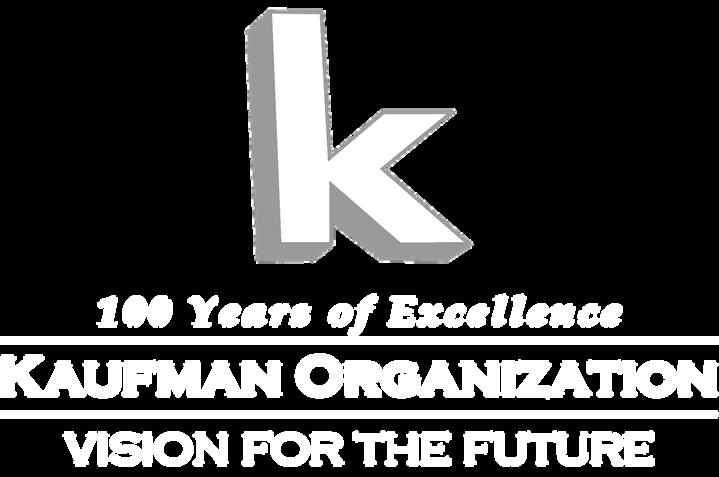

We would like to take this opportunity to thank the following people:
Our team & staff for their endless dedication and support
Our tenants for their cooperation to keep our buildings safe
Our partners for their trust and confidence in these challenging times
All New Yorkers working tirelessly to keep our city moving
We hope everyone continues to be healthy and safe in 2021.


Outdoor Power Equipment Institute
TurfMutt Foundation Equip Expo
1605 King St. Alexandria, VA 22314
turfmutt.com
opei.org
(703)549-7600
Clearing snow and ice from driveways, sidewalks and parking lots is no small job. Homeowners rely on their outdoor power equipment to do the heavy lifting, and it’s important to keep safety in mind. The Outdoor Power Equipment Institute (OPEI) reminds home and business owners to use snow throwers, often referred to as snow blowers, safely and offers tips to help.
Today’s weather is unpredictable, but preparation is key. OPEI encourages homeowners to keep the following tips in mind:
Review the owner’s manual. Check the owner’s manual for safe handling procedures. If the manual cannot be found, look it up online and store a copy on your computer so it’s available to reference in the future. Review how to operate controls. Be able to shut off equipment quickly.
Check equipment. The snow thrower should be powered off when being checked over. Adjust any cables and check the auger.
Charge batteries. Locate the batteries for your snow thrower and charge them fully before it snows.
Purchase fuel. Be sure to use the correct fuel recommended by the equipment manufacturer. For most gasoline-powered snow throwers, that is E10 or less. Often, fuel stations are closed after a storm, so buy gasoline in advance of storms. Fuel that is more than 30 days old can phase separate and cause operating problems.
For more information on fueling properly see opei.org/ programs/ethanolwarning.
Store and use fuel properly. Place gasoline in a proper fuel container and label it with the date purchased and the ethanol content. Store fuel safely and out of the reach of children. Fill the fuel tank outside before starting the engine and while the engine is cold. Never add fuel to a running or hot engine.
Clear the area. Snow can sometimes hide objects.
Doormats, hoses, balls, toys, boards, wires and other debris should be removed from areas you intend to clear. When run over by a snow thrower, these objects may harm the machine or people.
Dress for winter weather. Locate safety gear now and place it in an accessible closet or location. Wear safety glasses, gloves and footwear that can handle cold and slippery surfaces when operating the snow thrower.
KEY SAFETY TIP: Never put your hands inside the auger or chute. Use a clean-out tool to unclog snow or debris from the snow thrower.
Turn off the snow thrower if you need to clear a clog. If you need to remove debris or unclog snow, always turn off the snow thrower. Wait for all moving parts to come to a complete stop before clearing any clogs or debris.
Operate in visible conditions. Never operate the snow thrower without good visibility or light.
Aim with care. Never throw snow toward people or cars. Kids and pets may love to play in the white stuff, but it’s best to keep them inside your home and under supervision while you are using your snow thrower to clear a path or drive.
Do not allow them to play in the snow as it is tossed out of the snow thrower’s chute.
Use extreme caution on slopes and hills. Use caution when changing directions on slopes. Do not attempt to clear steep slopes.
Know where the cord is. If using an electric-powered snow thrower, be aware of where the power cord is at all times. Avoid tripping. Do not run over the power cord.
The Outdoor Power Equipment Institute (OPEI) is an international trade association representing more than 100 power equipment, engine and utility vehicle manufacturers and suppliers. To learn more, visit opei.org.
Langsam Property Services Corp. is a Bronx-based real estate management company. These buildings are located in the Bronx, Manhattan, Queens, Brooklyn, and lower Westchester County.
1601 Bronxdale Avenue
Bronx, New York 10462
Tel: 718. 518. 8000
Fax: 718.518. 8585

Mark Engel, CEO President
Langsam is designated as an Accredited Management Organization (AMO), a standard of excellence in management conferred by the Institute of Real Estate Management (IREM).




Debra Hazel Communications
North Las Vegas, NV debra@debrahazelcommunications. com (201)618-5247
It’s always good to come home for a couple of days for the ICSC New York conference in December, to learn more about industry trends, catch up with friends and do some real business.
Attendance at this major meeting still isn’t close to what it was in the pre-pandemic era — I heard estimates of about 8,000 this year, compared with 12,000 five years earlier — and for many, it was a one-day conference. I saw several CEOs departing late on the first day. But the second day also remained busy until the inevitable exodus around lunchtime.
Appointments were made and completed, and it appeared a healthy number of deals were being launched or done. In conversations with builders, analysts and more, what I found was an industry that’s focused on reinvention.
And that’s because retail real estate not only can, but must regularly rethink its mix to attract ever pickier and budget-constrained consumers.
It’s important to remember that “retail is the only sector where consumers choose to spend their time,” Brandon Isner, head of research, retail capital markets of Newmark, told me. “Consumers are spending, but it’s just more deliberate.”
Store closures came to 7,327 last year, up more than 57% over 2023, according to Coresight Research, so backfilling those spaces with the right uses for today’s customer is critical.
“One of the most important things after analytics is tenant curation,” said Barrie Scardina, president of Americas Retail Services for Cushman & Wakefield, at a panel on “The Right Mix.”
Research is important to begin the process, including data and a knowledge of the trade area.
“You have to know what a community needs,” said Holly Rome, executive vice presient of retail for JLL at the same panel. A plan can be created “once you have the basis of the ownership objectives and research. That translates to rent and rent translates to value.”
Now, developers are rethinking tenant mixes to appeal to a customer craving experiences and community rather than merchandise. Once undesirable tenants such as restaurants and wellness are now sought-after additions to a property
“We’re trying to help a developer create a sense of community,” Scardina said, adding that she is seeing interest in daycare centers. “What do they need? What is missing from the community?”
Experiential retail speaks to a wider realm, Isner not-
ed, but is dependent on location. What works in an affluent college town will be different in luxury gateway cities. And what works now may not in the nottoo-distant future.
To some degree, landlords and leasing agents have to be “fortune tellers,” said John Fahey, senior vice president at SRS Real Estate Partners, especially in growth markets.
And airports may be yet another opportunity, as the team involved with the development of JFK’s Terminal 6 related. But it won’t be easy.
“A lot of airports are focusing on the traveler experience, and Terminal 6 is no different,” said Karen Ali, COO of JFK Millennium Partners.
But there are major differences in logistics in this subsectror, as airport retail tends to be smaller, limiting the amount and types of merchandise that can be sold. In addition, the retailer and developer can’t control the entire experience — from delays that will bring more customers to the fact that shopping really isn’t the reason they’re at the venue.
In addition, construction costs are much higher and even hiring staff is more complicated because of necessary security checks.
Plus, the relationship with the customer is much more, pun intended, transitory.
“With an airport, you only get one bite of the apple. It’s so important to put the right brands in the right locations,” said Michael Golden, senior director of commercial leasing and strategy for Vantage Airport Group. “We try to get them to relax, to get them what they need.”
Meanwhile, Centennial Real Estate is leaning heavily into entertainment, signing three deals with multientertainment facility Round 1, and working with Level99 on other locations.
“Food and beverage is huge, as is entertainment,” said Paul Neuroth, executive vice president of leasing at Centennial Real Estate. Apparel companies including Aritizia, Athleta, Lululemon and Mizzen+Main continue to be in demand.
Don’t count out more traditional retail — Dick’s continues to expand, including new deals with Centennial. These types of boxes can replace long-vacant Sears buildings, just as, yes, pickleball can take former grocery locations. The sport clearly is proving that it’s more than a fad.
“Retail is always evolving,” Isner said. “And it will continue to evolve.”





More than 35 years of real estate, condominium & cooperative experience
WilkinGuttenplan uses expert industry knowledge in accounting, audit, and tax services to assist New York City real estate owners, developers, and investors of commercial and residential properties identify opportunities and guide them on implementing strategies to stay ahead of changing times.


Steve Tishco Partner
Greg Papeika Associate
Ditchik & Ditchik, PLLC
370 Lexington Ave., #1611
New York, NY 10017
steve@ditchik.com
greg@ditchik.com
(212)661-6400
On January 15, 2025, the New York City Department of Finance (DOF) published its tentative property tax assessment roll valuing all real estate in New York City as of the January 5, 2025 “taxable status date.” The final assessment roll will be published on or about May 25 and will affect property taxes due for the city’s 2025/26 fiscal year (July 1, 2025 – June 30, 2026).
New York City, unlike most jurisdictions, reassesses real property for property tax purposes every year. According to an initial look at the 2025/26 data, assessed values have generally increased year-overyear among all categories of properties throughout the city, with some notable exceptions.
These trends likely are reflective of the uneven post-pandemic recovery among the various classes of real property in New York City. For instance, assessed values of all commercial properties have increased on average citywide a modest 3.8%. That very broad number includes sub-categories such as hotels (up 4.5% in market value on the 2025/26 tentative assessment roll) and Class A offices (up 3.5%), as well as ones whose assessments decreased, such as older Class B offices (down 6.4%).
Another example is multifamily rentals, with unregulated rental property assessed values up 18.2%, as compared with a sub-1% average increase in regulated (i.e., rent-stabilized or rent-controlled) rentals, perhaps reflecting progressively diminishing returns from statutorily capped rent increases combined with inflation-driven operating expense increases. These average valuation changes in the numerous property types also vary widely among the five boroughs.
A more robust analysis of the new assessments will require a deeper look at many factors in the coming months, including trends in properties’ actual income and expenses (as well as vacancies and rents under newer leases) as compared with the economic factors applied by DOF in its valuations.
In recent years, as a consequence of the COVID-19 pandemic that began in early 2020, DOF has had only unstable and/or unreliable economic data with which to work and therefore mostly disregarded that data for valuation purposes from 2021/22 through 2024/25. In 2025/26, however, it appears that DOF has returned to considering properties’ reported income and expenses in its valuation analyses, at least in some building categories.
Of course, every property is unique, and the current economic circumstances of a particular parcel might not be consistent with its neighbors or the overall market. Thus, it is important that taxpayers review their properties’ performance along with their tentative 2025/26 assessments, and to discuss with their property tax counsel the benefits of filing a challenge to these valuations.
To that end, below is a brief description of the general timeline for annual property tax appeals in New York City:
January 5 (Taxable Status Date) — DOF sets assessed values for the fiscal year commencing July 1 based on the status and condition of property as of January 5 of each year.
January 15 — DOF publishes the tentative assessment roll, containing the tentative assessed values for each parcel of real property in the city. Between January 15 and the publication of the final assessment roll (on May 25), the law permits DOF to make changes to the assessed values.
March 1 — Deadline for filing assessment protests with the New York City Tax Commission for most property owners. (Single-, two- and three-family properties have until March 15 to do so). (Note that in 2025, this deadline is extended to March 3, due to March 1 falling on a Saturday.)
May 25 — DOF publishes the final assessment roll.
June 1 — Deadline for filing prior calendar year real property income and expense (RPIE) statements with DOF (via an online portal). The RPIE filing is separate and apart from the appeals process at the Tax Commission and is required by law in order to provide DOF with information relevant to setting the assessments for the next fiscal year (commencing 13 months in the future).
July 1 — Beginning of the fiscal year, the date on which the first installment of property taxes is due.
October 24 — Deadline to file a petition with the Supreme Court, the effect of which is to preserve a property owner’s right to continue to contest its assessment (at the trial court level).
As always, property owners should consult with their property tax counsel to discuss the specific requirements with respect to their own properties.
From financing considerations, to property performance metrics, today’s real estate business is inundated with both challenges and opportunities.
PKF O’Connor Davies has decades of experience working with a variety of assets including industrial, office and residential sites. Our experience in this complex field gives us the expertise to deliver strategic advice that drives real value.
With the PKF O’Connor Davies Real Estate Team, our clients know greater service, know greater insights, Know Greater Value.

Edward O’Connor, Partner 201.712.9800
eoconnor@pkfod.com

Brian Turner CEO OTI
brian.turner@oti.net
There appears to be a growing tension between sustainability and tenant experience across property management. But there needn’t be. Real estate is at a crossroads with sustainability. Green buildings must be a first thought, not a last thought. Coupled with this, tenant expectations for convenience and high-quality experience remain high.
Much-needed sustainable building regulations and standards have become prominent, with critical changes introduced in the last decade. In the U.S., we have New York’s Local Law 97 and Boston’s BERDO. The same is true in Europe, where the Minimum Energy Efficiency Standards, for example, aim to improve energy performance in commercial and residential properties. While these changes have largely been praised, a misconception remains: that green building initiatives create a higher upfront cost during construction or retrofitting, leading to increased rents or operating costs for tenants. Although this may seem alarming, improved building performance and reduced utility bills actually maximize long-term savings.
Growing market expectations for sustainable yet highly functional spaces do not just come from investors or regulators. Tenants also demand sustainable offices or living spaces, so their experience must be a priority for owners and operators. It goes beyond just keeping tenants happy: it is essential to ensure retention, maintain asset value and increase rental yield.
This idea of a battle — sustainability versus convenience — is concerning; it implies a trade-off that we shouldn’t have to make. But with the right technology, tension turns to opportunity. Master Systems Integrators (MSIs) are uniquely positioned to address this, bringing together technologies that prioritize both sides of the table so that neither has to be sacrificed.
The perception that sustainability may come at the cost of tenant experience needs to change. It is oversimplified. Tenants expect and deserve seamless operations — minimal downtime, responsive systems and high comfort levels. Certain sustainability goals may feel at odds with those expectations. But this is only true when technology is poorly implemented or tackled with an outdated strategy.
Additional compliance pressures only add to this complexity. But compliance doesn’t need to be complex.
The right technology, coupled with the right service providers, can reconcile these needs, creating sustainable and tenant-friendly buildings. Integrated systems streamline building management, reduce energy waste and improve user experience. Connecting technology to centralize systems simplifies compliance with local regulations while maintaining operational excellence,
keeping tenants happy. Not only do green buildings command premium rents, but they are more likely to improve tenant retention, observed JLL.
MSIs tailor solutions to specific building needs, rather than relying on a one-size-fits-all platform. They work with organizations to consolidate data, connect systems and provide a centralized view. This simplifies complex processes and systems, people can effectively collaborates and decision-makers are empowered by valuable data-driven insights. Working with experts to ensure optimal building performance means buildings can evolve with sustainability needs and requirements without sacrificing tenant comfort.
Rather than fixating on the complexities of balancing tenant satisfaction and improving sustainability in buildings, let’s focus on the positives. Sustainable, integrated systems are a win-win for all stakeholders. Efficiency is key here. Smarter buildings operate at optimal performance, improving usability while offering strong integrated systems that have longevity.
Optimized operations lower utility expenses and reduce the need for regular repairs, replacements and multiple maintenance requests and visits through predictive maintenance. Smart systems detect issues early, minimizing disruptions and ensuring comfort and high performance. This enables consistent heating or cooling, good air quality and responsive lighting.
A 2023 survey by the Building Owners and Managers Association (BOMA) found that tenant satisfaction increased by 18% in buildings utilizing smart building systems. Buildings with advanced systems are better placed to adapt to future sustainability requirements while considering tenant needs.
Looking ahead, we must remember that sustainability and tenant satisfaction are not mutually exclusive. These are complementary goals when in the hands of capable systems integrators.
The journey to smart, sustainable buildings has begun. The tools that will take the industry there already exist. But adaptability is paramount. Buildings must be able to evolve alongside emerging technologies and changing regulations, and adopting MSIs facilitates this. Owners and operators must seek technology partners with strong expertise to make their spaces efficient and enjoyable for tenants while ensuring their investments thrive.
This is an opportunity to innovate how we approach the built environment. By leveraging integrated, adaptable systems, building managers can create spaces that deliver on all fronts: efficiency, compliance and satisfaction. MSIs are at the heart of this transitional process toward a smarter and more sustainable built environment.








A new exhibition combining works by blue chip and emerging artists with digital art and NFTs

Practice Group Leader
New York Real Estate Practice Group
Holland & Knight 787 7th Ave., 31st Floor New York, NY 10019
stuart.saft@hklaw.com (212)513-3308
On New Year’s Eve, 2024, the United States Department of Justice (DOJ) sought an emergency order from the United States Supreme Court to stay a preliminary nationwide injunction in a dispute between small business, including co-ops and condominiums, over the Corporate Transparency Act (CTA).
Enacted in 2021, the CTA required that by January 1, 2025 entities, including cooperatives and condominiums, had to file a report identifying personal identifying information (PII) about the individual beneficial owners (BOI) who directly or indirectly own or control the entity, with the U.S. Department of the Treasury’s Financial Crimes Enforcement Network (FinCEN) and file a report whenever the information changes. The stated purpose of the CTA is to counter financial crimes.
FinCEN had estimated that about 32.6 million entities were required to report BOI to FinCEN by January 1, 2025 and about 20 million have not done so. More than a dozen lawsuits have been filed contesting the constitutionality of the CTA and at least 25 states are supporting businesses challenging the constitutionality of the CTA.
On December 3, 2024, a federal district court in Texas issued a nationwide preliminary injunction against the CTA and on December 31, 2024, the DOJ filed an emergency application with the United States Supreme Court to lift the injunction and reinstitute the reporting regime of the CTA. If the Supreme Court sides with FinCEN, the 20 million entities would have to immediately file.
Small business owners including representatives of co-op and condos oppose CTA for the following reasons:
1. The government is requiring BOI, which purportedly will be maintained on a secure server, in a secure location. However, is any repository of information secure considering the Chinese breaking into Treasury’s computer system?
2. The cost of complying with the CTA can be far more than the government estimates of $85 per company because the rules are vague and difficult to apply, thereby requiring the assistance of professional advisors; reporting companies have to adopt policies and procedures to update BOI information and many of the beneficial owners have to retain counsel and separately decide whether they want to continue to serve on a board where developing situations could lead to potential personal liability and the unwanted release of PII.
3. How companies that own a single property could be perceived as affecting interstate commerce.
4. This process could have been more reasonably accomplished by having the federal tax return of every entity reflect the names and addresses of the beneficial owners, rather than creating a separate bureaucracy with the willful failure to file and update forms punishable by fines and jail.
5. A belief that only honest businesses would be registering and be compliant with the CTA, and that money launderers would evade the CTA.
6. The fear that the Treasury Department will use the beneficial owner lists to target taxpayers for audit, whether for financial, political or other improper bases.
7. If reporting deadlines are not suspended until the constitutionality of the CTA is adjudicated, the compulsion for beneficial owners to file BOI reports would unfairly prejudice their claims.
It is important to note that the CTA is not about the source of funds to buy co-ops, condos or other real estate, which is covered by other regulations that are not being challenged.
I view this dispute from a unique perspective — I am the president of my co-op board and chair of the Council of New York Cooperatives and Condominiums (CNYC). The CTA applies to both my 72-apartment co-op building and the CNYC. Our concern is not money laundering but it is about keeping our homes affordable in light of neverending costly mandates from the city, state and, now, the federal government.
The CTA was supported by New York’s congressional delegation when it was enacted. Now a bill has been introduced in Congress to repeal the CTA and neither our U.S. senators nor members of Congress support the repeal. Our representatives have never explained the rationale for enacting legislation that requires more than 7,000 New York City co-op and condo buildings containing the homes of over 700,000 New Yorkers and a nonprofit organization to file personal information reports with FinCEN.
Every NYC co-op and condo owner should consider contacting their members of Congress and urging them to support the repeal. It’s vital to protect homeowners, reduce unnecessary burdens and ensure that housing remains affordable, accessible and secure for all New Yorkers.














• 3 Sides of Windows • Flooded with light • 24/7 Building Access
• Owner Occupied • Access to all transit









Photos by Jim Sink Photography
The redesign of Johnson Lexus of Durham marks the architecture firm’s entry into the automotive design sector
New branding met three-decade-old infrastructure with MVE + Partners’ redesign of the Johnson Lexus Dealership of Durham, N.C. Working with the existing building structure and aligning with new Lexus brand standards, MVE created a design that is functional, operational and revenuegenerating while keeping the guest experience at its core.
MVE’s planning strategy transformed the nearly 100,000-square-foot dealership, creating a seamless flow for guests regardless of whether they are browsing, purchasing or going in for service. The team used a holistic design approach to all programmed areas including the main showroom, guest lounges, snack and refreshment areas, service drop-off and car delivery, with an experience that is welcoming and comfortable, while effectively displaying the Lexus brand and cars.
“The intention of the design and rebranding
of the Johnson Lexus dealership of Durham was to design a dealership that enhances the brand and creates a unique guest experience that leaves a strong lasting impression,” said Kap Malik, FAIA, principal at MVE.
Located at the juncture of Interstate 40 and Route 751, customers are easily guided into the dealership from the freeway. The building’s overall color and materials echo the Lexus brand’s sophistication. The form of the ceilings and striking light fixtures in the showroom are inspired by the Lexus car grill.
The guest consultation areas are in the form of “tripods” and use patterned glass. This allows for intimate conversations while remaining a part of the overall showroom experience and connected to the automobiles. Every programmed area of the dealership enhances operational functionality. Using innovative technology and a personal check-in, guests are welcomed to the space. The intuitive floor and
ceiling designs then effortlessly guide guests through the space.
All building materials used in the dealership are efficient and sustainable. The incorporation of high-performance glass reduces glare and heat transmission in the building, allowing the optimization of the mechanical building systems for the dealership. The entire building is also designed to sustain heavy wind loads, as North Carolina is prone to hurricanes and extreme weather events.
Additional partners on the project include Choate Construction Company (general contractor), Morrison Engineers PLLC (structural engineering), Bass Nixon and Kennedy Inc. (MEP) and Lighting Design Alliance (LDA).
Through its varied architectural capabilities, MVE has designed Honda, Porsche, Subaru and Lexus dealerships that provide brandimmersive experiences for guests.

Photos by Bjorg Magnea

By Philip J. Consalvo, Principal, PJCArchitecture
Congratulations — you’ve just bought your first property in New York City! But, like most of the city’s coveted apartments and charming brownstones, your new space has room for improvement.
With some of the nation’s strictest building codes, complex compliance requirements and a maze of property regulations, it’s no surprise that many homeowners are intimidated and overwhelmed by the process. At PJCArchitecture, we’ve had the privilege of helping dozens of New Yorkers navigate the nuances of designing and renovating in the city. While no two projects are alike, our years of experience have equipped us to guide our clients through the process with confidence. Here, we share some key insights and considerations to help you plan and realize your dream space on time and on budget.
Managing your expectations is key, especially if this is your first renovation. Construction costs are often higher than anticipated. Understanding and balancing these costs in advance is essential.
The costs of labor have steadily increased in recent years, so while it may be tempting to splurge on premium materials, avoid doing so at the expense of quality work. Plan early on when making design choices so you can allocate your budget accordingly.
It is important to stay flexible. Navigating building codes and regulations, permit processes, site conditions and potential supply chain shortages often requires adaptation. They say constraints inspire creativity, and some of the highlights in your finished home could be the result of unexpected changes along the way. Embrace flexibility, and a skilled proj-

ect team will likely exceed your initial expectations.
We keep hinting at these tricky codes and regulations, so let’s dive into the must-knows.
First and foremost is ADA compliance, a critical factor in New York City even for residential spaces. This requirement can be particularly challenging in smaller units, where the proper clearance needed for doorways and hallways will impact your floor plan. In landmarked buildings, altering the façade will generate additional work including design studies, drawings and approvals.
Another common surprise for homeowners is the “wet over dry” rule, which limits placement of bathrooms, kitchens and laundry areas. This may also affect how much you can alter or expand these spaces.
Beyond city regulations, many New Yorkers must also adhere to their building’s rules and guidelines. Your HOA or building management may enforce additional requirements that can increase the scope of work, such as the replacement of windows and old piping and/or the addition of shutoff valves. These regulations may benefit the building and its infrastructure but will typically add costs. Ensure you fully understand your building’s requirements and constraints before finalizing your plans.
Renovation timeline restrictions are another frequent challenge in shared buildings. To minimize disruptions to neighbors, building boards often impose time caps for work and construction. In some cases, pausing the project may be necessary to stay within the allotted timeframe. In one recent project,

cabinetry couldn’t be measured and fabricated until demolition was complete. Rather than lose valuable time, we paused the renovation process entirely until the cabinetry was ready for installation. We were diligent in keeping the building board informed to ensure the downtime didn’t count against us.
Lastly, infrastructure limitations in older buildings can pose challenges. Many lack sufficient electrical capacity to support features like clothes dryers, certain kitchen appliances, split AC systems or other power-intensive upgrades. Many older buildings lack the infrastructure to add additional plumbing fixtures and appliances. Being proactive can help ensure a smoother renovation process.
To navigate these regulations and still achieve a space you love, we recommend collaborating with an architect. Their technical expertise and creative problem-solving skills can help you find thoughtful solutions without compromising your goals.
The most essential takeaway is hire the right support team. Project costs tend to be high, but it is a mistake to make your decisions based solely on costs. A good team will guide you in selecting the proper materials and making smart, efficient choices. They will help you design within your budget and establish realistic parameters, all while achieving a creative result. Seek testimonials from friends and neighbors or ask for referrals when evaluating consultants, designers and construction companies.
Renovating in New York City can feel daunting, but with the right knowledge and team, the process can be as rewarding as the finished product.




At Webster Bank, you’ll find products designed for the property management industry – and a team of professionals with the experience to put them to work for you. Your Webster Bank Relationship Manager and Property Management Team know the challenges you face and give you access to the tools you need to e ectively manage them.
Value, solutions and service – put our resources to work for you.








Law firm Kramer Levin has elevated Boaz I. Cohen, Nicole S. DeBare and Sheila M. Pozon to partner positions. All three are based in New York City.
“These exceptional lawyers have demonstrated an outstanding commitment to the firm and our clients,” said co-managing partners Paul H. Schoeman and Howard T. Spilko. “We are proud to recognize their achievements and their contributions toward growing their respective practice areas. We look forward to their continued success as part of our partnership.”
Cohen litigates complex commercial disputes, including false advertising matters. He also represents individuals and entities in criminal and civil white-collar matters, including in investigations and enforcement proceedings before government and regulatory agencies such as the Securities and Exchange Commission and the Public Company Accounting Oversight Board. Cohen earned his J.D. from New York University School of Law and graduated cum laude with a B.A. in psychology and computer science from Columbia University.

DeBare represents some of New York City’s most prominent developers, investors, lenders and not-for-profit institutions in real estate transactions, with a particular focus on condominiums and cooperatives. She represents developers in filings before the New York State Attorney General for complex real estate projects, including commercial condominiums featuring multifamily units, luxury hotels, retail spaces and parking facilities. She also has extensive experience in negotiating condominium governance documents on behalf of her developer, investor and lender clients, with nearly 20 years of experience both in the New York City market and in major cities around the country. She earned her J.D. from Brooklyn Law School and graduated cum laude with a B.A. in history and philosophy from Binghamton University.
Pozon represents private developers and property owners; cultural, educational, health care and nonprofit institutions; lenders and investors in the planning, acquisition, development and financing of major projects throughout New York City, on municipal law issues, the development potential of sites and the land use and environmental review processes. She has extensive experience representing clients in high-profile real estate projects, including advising the Port Authority of New York and New Jersey on the $10 billion redevelopment of the existing Midtown Bus Terminal and Extell Development Co. on the assemblage and acquisition of development rights for landmark Manhattan projects such as the International Gem Tower, One57 and Central Park Tower. Pozon earned her J.D. from Boston University School of Law and her B.A. in art history and visual arts from Columbia University.

Multifamily investment management and developer Cityview has named Christoph Donner as a principal and global head of capital development and strategy. Based in New York City, Donner will pursue new global strategic opportunities, build and maintain relationships with investors and partners, lead the firm’s fund development and capital strategy and oversee the launch and growth of a new East Coast office for the firm.
“Christoph’s deep understanding of the financial markets and strong background in global real estate investments will be invaluable to Cityview as we grow the international reach of our capital development strategy,” said Sean Burton, CEO of Cityview. “We are excited to kick off what we believe will be a great vintage year with Christoph’s hire as we expand our national and international relationships while pursuing strategic development and value-add acquisition opportunities for the firm.”
Donner’s hire comes at a time of rapid growth for Cityview when the firm is highly
focused on expanding the firm’s global capital raising efforts and deploying capital from its recently closed seventh discretionary fund. He will also head the firm’s investor relations team, working closely with Managing Director Jennifer Halvas, and serve as a member of Cityview’s investment committee.
“Now is an exciting period of growth for the firm, and I couldn’t be more thrilled to bring my expertise to Cityview as we work to expand our relationships with investors and partners, and establish a presence on the East Coast,” said Donner. “The fundamentals of multifamily continue to be strong, and I look forward to broadening Cityview’s national and international relationships and working to open up new global capital development opportunities for the firm.”
Donner was previously CEO of America Pimco Prime Real Estate LLC (formerly Allianz Real Estate of America LLC), where he provided strategic leadership over the commercial mortgage loan business and equity investments of Allianz’s global subsidiaries in North America. During his time as CEO, the firm’s real estate investments grew from $7 billion to $22 billion.
Prior to that, he was a senior managing director and chief credit officer at Aareal Capital Corporation, where he managed a portfolio of $5 billion. He has also served as managing director at Hypo Real Estate in New York, London and Munich; head of project finance at Vivico Real Estate in Frankfurt, Germany and as a vice president at Deutsche Bank in Frankfurt.

Newmark announces the addition of Dave Aschenbrand as Executive Managing Director to advance and further expand cold chain services alongside Executive Managing Director Adam Petrillo.
With over 25 years of sector experience spanning capital markets, leasing, supply chain and cold storage solutions, Aschenbrand’s appointment elevates and fortifies the company’s industrial cold chain capabilities globally, providing holistic and differentiated advisory with integrated specialists to support clients at each stage of the real estate life cycle for the highly nuanced asset class, Newmark said.
“Cold storage continues to thrive as a key segment in the commercial real estate market, and Newmark is strategically expanding its capabilities to meet the growing demand and to deliver specialized solutions in a sector that requires both precision and scale,” said Jack Fraker, president, global head of industrial and logistics, capital markets.
“Hiring top-tier professionals like Dave enables us to lead in delivering innovative solutions to our clients. With a solid track record of delivering impactful, industry-leading solutions, his approach drives value across the supply chain,

Charney Companies announced that veteran broker Frank Giordano has joined Charney Brokerage as director of brokerage services. Established in 2019, Charney Brokerage is a boutique agency servicing third parties and operating Charney’s in-house sales, leasing, marketing and branding team. In his new role, Giordano will help expand the company’s brokerage reach, as well as continue his work with sales, rentals and investments.
“[Last] year has been key for our company in the growth of our team. We have been focused on bringing in the right people to continue expanding across all our divisions and Frank’s expertise will be vital as we continue to grow and enhance our brokerage services,” said Sam Charney, principal, Charney Companies.
Prior to joining Charney Companies, Giordano began his

In a move that he said will further strengthen homebuilder B2K Development, CEO Steven Krieger announced the appointment of Benjamin Hatz as the company’s new chief operating officer.
“Ben brings with him over 25 years of exceptional experience in the commercial real estate industry, including expertise in acquisitions, financing, asset management, equity raising, joint ventures and project execution,” Krieger said.
“His proven leadership capabilities and forward-thinking strategies perfectly align with our company’s vision, positioning B2K Development for continued strategic growth in the months and years to come.”
Over the decades Hatz has brought his professional skills to a broad range of real estate projects that included transactions in multifamily, medical office, hotel and industrial/ warehouse/logistics properties in major U.S. markets. He is highly regarded as a respected and trusted advisor
ensuring clients receive best-in-class advisory tailored to meet their unique needs.”
Based in New Jersey, Aschenbrand joins Newmark with an extensive industrial background that encompasses material handling system integration, temperature-controlled public refrigerated warehousing, industrial cold storage real estate development and multimodal North American and port logistics transportation solutions.
His clients and partners have included industry leaders such as FreezPak Logistics and FlexCold.
“As a renowned subject matter expert in cold storage, with a profound understanding of both the market and the complexities of this asset class, Dave will be instrumental in centralizing and strengthening all facets of our North American cold chain capabilities,” said Petrillo. “The seamless integration of best-in-class solutions across our services will continue to set Newmark apart, reinforcing our leadership in both cold storage and other high-growth asset classes as we drive innovation and set new standards across the industry.”
real estate career at Town Residential, where he spent three and a half years before moving to Compass in 2014, where he was one of the first 20 agents.
At Compass, Giordano gained a diverse background within the real estate industry, specializing in luxury sales, rentals, investments and new development. He also worked with several top producing agents and on new developments including One York, 70 Greene St. and 88 Franklin St.
Giordano has also worked with investors on leasing and managing over 40 luxury rentals for individual owners. Over his career spanning 14 years, Giordano has sold over $300 million worth of real estate.
Giordano is a graduate of the Lubin School of Business at Pace University, where he studied entrepreneurship.
on strategic corporate decisions, structuring and executing commercial real estate transactions that drive business growth, B2K said in the announcement.
In addition to his extensive business background, Hatz holds a master’s degree in finance and real estate from Columbia Business School and a bachelor’s degree from Cornell University.
Based in Jericho, Long island, B2K Development has long been recognized as award-winning home builders who have created over 5,000 homes during the past two decades.
Their efforts have built communities with an array of services and amenities designed to fit all types of lifestyles. Those residences include Sutton Landing, The Brix, The Seasons 55+ condominiums, Doubleday Court, Aqua on the Ocean, The Breeze, The Boardwalk, Ocean Grande, The Bel-Aire, Wellbridge, Encore Luxury Living and The Bristal Assisted Living communities.
3


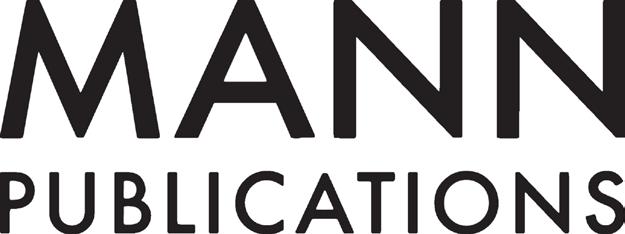


Robert Wasmund Founder & CEO
Ascent Developer Solutions
Robert Wasmund, founder and CEO of Ascent Developer Solutions (AscentDS), holds over 30 years of expertise, specializing in lending, investment and development.
As the former CEO of Genesis Capital, he led its growth from $100 million to $2.5 billion in annual originations and secured landmark investments from Oaktree Capital and Goldman Sachs, making Genesis one of the first private lenders to partner with a regulated financial institution.
Wasmund’s career and vision was also forged from his time as partner at Anchor Loans, where he led the acquisition and repositioning of more than 1,000 assets totaling over $200 million in three years during the Great Financial Crisis.
He attended the University of North Florida and is a graduate of the U.S. Naval Nuclear Power School, serving as a reactor operator for five years on the U.S.S. Enterprise. In his spare time, he competes as a semi-professional baseball player, winning multiple national titles since 2002.
How long have you been in the industry? I have been in the real estate finance industry for more than 30 years.
What brought you into the business?
I entered the business during my time as a professional poker player, when I began investing personal capital into trust deeds. Recognizing firsthand the strong returns and manageable risk that resulted from these investment opportunities, I felt compelled to make a move in the industry and turn this into a career. This led me to co-found Anchor Loans in 1998, marking my formal entrance into the private lending and real estate finance sector.
Serving as partner at Anchor during the great financial crisis, I learned the critical importance of data analytics and the value of having in-house valuation and construction capabilities at your fingertips, and this has been an approach I have leveraged in every venture I have led since, including at Genesis Capital and, now, Ascent Developer Solutions.
Who inspires you?
Steve Jobs.
Why did you form AscentDS?
The nature of the financing landscape over the past few years, marked by quantitative tightening, the retreat of regional banks and high interest rates, presented a unique opportunity to leverage more than a decade of success and a nuanced industry perspective to fill substantial gaps in the lending environment.
The conception of AscentDS was a direct response to this, providing customized lending solutions with
speed, agility and reliability that fulfill a natural demand for new construction and renovation investments amidst persistent housing undersupply and an aging housing stock.
Partnering with Elliott Investment Management in this endeavor has been key, as they share our vision of leveraging partnerships with institutional capital to expand the private lending sector, and this collaboration is integral to our growth trajectory as we aim to build out a market-leading developer finance business.
Is there a particular housing segment that is more in favor now?
I am particularly bullish about the homebuilding residential sector, specifically luxury product as well as those in the top 25 metropolitan markets, where we anticipate having a continued presence, further growth and strong investment returns.
Additionally, accessory dwelling units (ADUs) have emerged as a promising lending opportunity, as they offer more versatile housing opportunities during a period of a national housing shortage and rising cost of traditional homes. ADUs have especially gained popularity among aging demographics, as they offer autonomy and livability while remaining affordable. This asset class also addresses the challenge of constrained land availability, and as we continue to see increasing zoning accommodations being implemented for the market, we expect to see steady and sustainable growth in demand. [Editor’s note: for more on ADUs, see story, page 60.]
How have recent interest rate cuts affected your business?
The recent rate cuts have created more compelling and attractive market opportunities for single- and multifamily developers, and we are witnessing a renewed sense of optimism amongst both borrowers and lenders. Multifamily and build-for-rent, which faced challenges due to high rates, are now poised for recovery, and we expect transaction activity to gain momentum.
While banks may gradually re-enter the lending space in the coming years, private lenders will continue to step up to the plate and play a crucial role. While this need was amplified over the past few years given the pressures and failures of regional banks, even with a potential return of banks in the future there will always be a need and responsibility for private capital to fill a gap in lending. Loan demand has already doubled what it was just two to three months ago, and I anticipate this upward trend will accelerate well into 2025, establishing a new growth cycle.
What keeps you up at night?
I am concerned with both the geopolitical landscape as well as continued inflation in the United States.

The financial backing of a global bank, and the streamlined structure and agility of a boutique bank that will keep your business moving forward.
BHI offers full commercial banking services that combine the personal attention of a prestigious boutique bank with the expertise and financial strength of Bank Hapoalim – the leading financial institution in Israel.
With a footprint in the largest U.S. metropolitan areas, we are committed to creating innovative funding solutions for your short– and long-term needs and providing convenient banking and liquidity products for your everyday business needs.
www.bhiusa.com
61%
Granny flats, casitas, in-law units — whatever you call them, accessory dwelling units (ADUs) are a growing segment of residential real estate. These small (typically 600 square feet to 1,200 square feet), fully equipped dwellings built in the backyard or above the garage of a house can solve a number of problems, from a nearby residence for an aging parent to a first home for a young adult to a way to earn extra rental income. Popular in California and the Sunbelt, ADUs could be a major factor to solving the housing shortage, as you can see by the numbers.
The percentage of homeowners who cited multigenerational housing as a motivation for building an ADU. (OnePoll survey, 2023)
1.4 million
The number of legal ADUs in the United States as of early 2023. (Freddie Mac)
$10.6 billion
The projected global value of the ADU market in 2030, up from $3.3 billion in 2023. (Verified Market Research)
22,802
The approximate number of ADUs built in California in 2023, up from 10,000 in 2021. (California Department of Housing and Community Development)
$180,000
The average cost to build an ADU, though prices vary dramatically depending on location, size and design. (Angi)
35%
The additional value that building an ADU brings to homes in big cities. (Porch.com)

Zetlin & De Chiara LLP, one of the country’s leading law firms, has built a reputation on counseling clients through complex issues. Whether negotiating a contract, resolving a dispute, or providing guidance to navigate the construction process, Zetlin & De Chiara is recognized as a “go-to firm for construction.”
